| "Taj Mahal" (Columbia, Feb. 1968) |
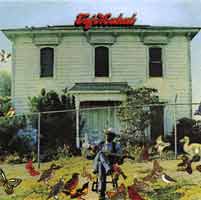 Mahals DebĂ¼talbum. In seiner Band hatte er damals gleich zwei herausragende Gitarristen: Jesse Ed Davis und Ry Cooder.
Mahals DebĂ¼talbum. In seiner Band hatte er damals gleich zwei herausragende Gitarristen: Jesse Ed Davis und Ry Cooder.
|
| Leonard Cohen: "Songs Of Leonard Cohen" (Columbia, Feb. 1968) |
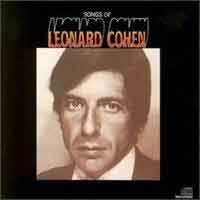 Cohen
war vor diesem musikalischen DebĂ¼t schon als Dichter in Erscheinung getreten
und auch bereits in seinen DreiĂŸigern. Die Platte war sehr erfolgreich
und enthält einige seiner grĂ¶ĂŸten Hits: "Suzanne", "Sisters
Of Mercy" und "So Long Marianne". Cohen
war vor diesem musikalischen DebĂ¼t schon als Dichter in Erscheinung getreten
und auch bereits in seinen DreiĂŸigern. Die Platte war sehr erfolgreich
und enthält einige seiner grĂ¶ĂŸten Hits: "Suzanne", "Sisters
Of Mercy" und "So Long Marianne". |
| Love: "Forever Changes" (Elektra, Feb. 1968) |
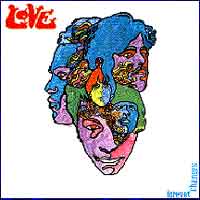 Definitiv eines meines Lieblinxalben aus den 60ern!
Definitiv eines meines Lieblinxalben aus den 60ern!
|
| Otis Redding: "Dock Of The Bay" (Atco, Feb. 1968) |
 Posthum hatte Otis mit dem Titelsong seinen grĂ¶ĂŸten Hit!
Posthum hatte Otis mit dem Titelsong seinen grĂ¶ĂŸten Hit!
|
| Miles Davis: "Nefertiti" (Columbia, März 1968) |
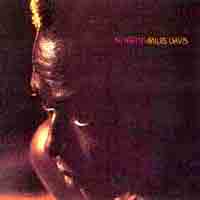 Eine der besten Jazzplatten aus dieser Zeit und eine der letzten Davis-Platten
mit dem alten Quintett - Herbie Hancock (p), Wayne Shorter
(sax), Ron Carter (bass) und Tony Williams (dr) - im alten
akustischen Sound.
Eine der besten Jazzplatten aus dieser Zeit und eine der letzten Davis-Platten
mit dem alten Quintett - Herbie Hancock (p), Wayne Shorter
(sax), Ron Carter (bass) und Tony Williams (dr) - im alten
akustischen Sound.

 Mehr ...
Mehr ...
This was the first Miles I bought, in black vinyl when it was released in '68. Why I was drawn to buy it, I don't know. I knew little about jazz and nothing about Miles's music. As a new release, the album was on prominently display in the shop and somehow, mesemerised by the cover [which I still find deeply enigmatic], I felt I had to buy it. I have played it constantly, ever since. It has taken me years come to some modest understanding of this music, long after the extraordinary feeling conveyed by it had captivated me. The striking aspect of this album is the pivotal role played by drummer Tony Williams. It's remarkable that, at 17 years old, Williams's playing forms the canvas upon which Miles Davis, Herbie Hancock and Wayne Shorter paint the forms and colours of this sublime music. Dave Holland's bass provides the rythmic underpinning, occasionally being visited by Williams, before he rejoins the others in the forefront of the picture.Nefertiti is no K of B. One doesn't relax straight into it on first hearing, as anyone surely does with that earlier album. It presents a complexity that K o B does not have, despite the K o B band having four solo voices, including the giant talent of Coltrane. The primary role that Williams plays on Neferetiti seems disturbing at first but [for me] the beautiful logic and feeling contained in this music has gradually revealed itself and has become endlessly rewarding and essential to my enjoyment of Miles Davis.
()
|
| The Incredible String Band: "The Hangman's Beautiful Daughter" (Elektra, März 1968) |
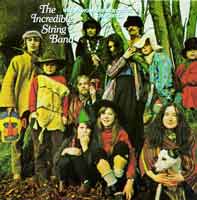 In den Jahren 1967-69 war die schottischen Multiinstrumentalisten Mike Heron
und Robin Williamson mit ihrer originellen Mischung
aus Folk- und Weltmusik sehr erfolgreich und brachten es in dieser Zeit
zu 5 Alben. Das lief meistens so ab: abwechselnd sang einer sein Lied
und begleitete sich vornehmlich auf der Gitarre, während der andere jeweils
fĂ¼r Arrangement und zusätzliche Instrumente zuständig war. Gegenseitig
stachelten sich sich dabei zu Höchstleistungen an. Manchmal lieĂŸen sich
sich auch von ihren Freundinnen begleiten (und ablenken?) oder hatten
einmal sogar eine Balletttruppe dabei. Heutzutage hätte wohl kaum eine
groĂŸe Plattenfirma soviel Gottvertrauen in ihre Musiker wie Elektra damals!
Produziert hatte der in London ansässige Amerikaner Joe Boyd (erste
Pink Floyd-Single "See Emily Play", Fairport
Convention, etc.)
In den Jahren 1967-69 war die schottischen Multiinstrumentalisten Mike Heron
und Robin Williamson mit ihrer originellen Mischung
aus Folk- und Weltmusik sehr erfolgreich und brachten es in dieser Zeit
zu 5 Alben. Das lief meistens so ab: abwechselnd sang einer sein Lied
und begleitete sich vornehmlich auf der Gitarre, während der andere jeweils
fĂ¼r Arrangement und zusätzliche Instrumente zuständig war. Gegenseitig
stachelten sich sich dabei zu Höchstleistungen an. Manchmal lieĂŸen sich
sich auch von ihren Freundinnen begleiten (und ablenken?) oder hatten
einmal sogar eine Balletttruppe dabei. Heutzutage hätte wohl kaum eine
groĂŸe Plattenfirma soviel Gottvertrauen in ihre Musiker wie Elektra damals!
Produziert hatte der in London ansässige Amerikaner Joe Boyd (erste
Pink Floyd-Single "See Emily Play", Fairport
Convention, etc.)

 Mehr ...
Mehr ...

The Hangman's Beautiful Daughter is one of the most unimpeachably outside discs ever waxed by a pair of hallucinating hippies. The roots of The Incredible String Band lie deep in the corners of the Scottish folk scene, with Robin Williamson and Clive Palmer touting transported bluegrass around the late-night boozers of the central belt. With the addition of guitarist Mike Heron the trio cut some fairly unremarkable folk standards - alongside a couple of beautifully puzzling originals that so stirred maverick record producer Joe Boyd that he signed them to the newly-inked British wing of Elektra.
Their first, self-titled, album came out in 1966, featuring spidery re-workings of traditional material, but after it failed to do much damage the trio split and followed the hash clouds to Morocco and Afghanistan. By the time they reformed they'd lost Palmer but had glimpsed the other side and began trying to map their rewired synapses via some fantastically dislocated song forms, an approach which reached its acme with 1968's The Hangman's Beautiful Daughter.
From the alluring half-light of the cover shot, via serpentine, episodic song-structures, ethnic drones and song-poems that spoke of Ur-pagan conceits and mythic archetypes, they created a truly timeless slab of mutant folk that transports you off to a never-never land that's full of whimsy and vague melancholy. Indeed it feels like it was dictated, like the duo opened themselves to the skies and just let it come down.
|
| Laura Nyro: "Eli And The Thirteenth Confession" (Columbia, März 1968) |
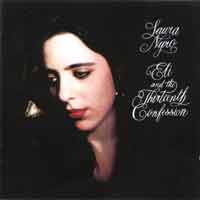 Mit gerade mal 21 Jahren war Laura Nyro schon eine der wichtigsten Sängerinnen,
Pianistinnen und Songschreiberinnen ihrer Generation! Sie verband Jazz,
Soul, Pop und Musical zu einer einzigartigen Mischung. Dies ist ihr zweites
Album und ihr DebĂ¼t bei Columbia und enthält einige ihrer grĂ¶ĂŸten Songs,
die allerdings nur in Versionen anderer KĂ¼nstler bekannt wurden: The
Fifth Dimension nahmen "Sweet Blindness" und "Stoned
Soul Picnic" auf, Three Dog Night den Titelsong "Eli's
Coming". Ohne Laura Nyro's Pionierarbeit sind solche KĂ¼nstlerinnen
wie Ricky Lee Jones, Suzanne Vega, Tori Amos und
auch Ani DiFranco kaum vorstellbar!
Mit gerade mal 21 Jahren war Laura Nyro schon eine der wichtigsten Sängerinnen,
Pianistinnen und Songschreiberinnen ihrer Generation! Sie verband Jazz,
Soul, Pop und Musical zu einer einzigartigen Mischung. Dies ist ihr zweites
Album und ihr DebĂ¼t bei Columbia und enthält einige ihrer grĂ¶ĂŸten Songs,
die allerdings nur in Versionen anderer KĂ¼nstler bekannt wurden: The
Fifth Dimension nahmen "Sweet Blindness" und "Stoned
Soul Picnic" auf, Three Dog Night den Titelsong "Eli's
Coming". Ohne Laura Nyro's Pionierarbeit sind solche KĂ¼nstlerinnen
wie Ricky Lee Jones, Suzanne Vega, Tori Amos und
auch Ani DiFranco kaum vorstellbar! |
| "The Pentangle" (Transatlantic, März 1968) |
 Pentangles DebĂ¼talbum habe ich erst relativ spät entdeckt (natĂ¼rlich in
der CD-Grabbelkiste), aber es hat schon alles, was die späteren Alben
so groĂŸartig macht. Das liegt sicherlich auch daran, dass alle Beteiligten
keine Newcomer, sondern bereits etablierte und ausgereifte Musiker waren.
Pentangles DebĂ¼talbum habe ich erst relativ spät entdeckt (natĂ¼rlich in
der CD-Grabbelkiste), aber es hat schon alles, was die späteren Alben
so groĂŸartig macht. Das liegt sicherlich auch daran, dass alle Beteiligten
keine Newcomer, sondern bereits etablierte und ausgereifte Musiker waren.

 Mehr ...
Mehr ...
|
There's something exciting about the first album of a band that goes
on to greatness, and The Pentangle, by the group of the same name, is
no different. Here, the listener witnesses the first studio work of a
band struggling to get their essence down on vinyl. Of course Bert Jansch
and John Renbourn's reputations as guitarists preceded the band, but the
addition of bassist Danny Thompson and drummer Terry Cox gave the band
an acoustic rhythm section like no other folk-rock group. Singer Jacqui
McShee became the last piece of this intricate English puzzle, delivering
high, expressive vocals that contrasted and merged so well with Jansch's
deeper pipes. The group doesn't hold back on their first outing. On "Hear
My Call" McShee offers a dreamy vocal, floating high above the bluesy
guitars. The soaring vocal and firmly grounded rhythm highlight one another,
creating a carefully layered sound that is present in all of Pentangle's
best music. This dynamic works equally well in "Pentangling,"
with McShee and Jansch's voices combining light and dark shadows to concoct
a strangely atmospheric harmony. The rocking and rollicking "Way
Behind the Sun" is another standout, and the instrumentals "Bells"
and "Waltz" are complex and lively. The album's spacious arrangements
take full advantage of stereo, mixing instruments to different tracks
so that the listener, for instance, can always hear Jansch's guitar on
one side and Renbourn's on the other. This group, it seems, had it all.
Equally comfortable with traditional songs, instrumentals, and originals,
they made few missteps on their early albums. Like Fairport Convention
and the Incredible String Band, Pentangle specialized in updating British
Isles' folk music. The Pentangle, now with seven bonus tracks, is a dazzling
debut and a must have for fans of English folk rock.
(by Ronnie D. Lankford, Jr., All
Music Guide)
|
|
| The Electric Flag: "A Long Time Comin'" (Columbia, April 1968) |


 Mehr ...
Mehr ...
UrsprĂ¼nglich erschien das erste reguläre Album A Long Time Comin’ der vom legendären Bluesrock-Gitarristen Mike Bloomfield gegrĂ¼ndeten Electric Flag im Jahr 1968.
Das Album das von ungewöhnlichen Bläser-Arrangements geprägt war, schaffte es mit einer ungewöhnlichen Mischung aus Blues, Rock, Soul, Country und Jazz sogar in die Billboard Pop Charts.
Neben Bloomfield gehörten mit Musikern wie Buddy Miles (Drums, Vocals), Barry Goldberg (Keyboards) oder Michael Fonfara (Keyboards) auch weitere prägende Namen der Rockgeschichte zum damaligen Line-Up der Band.
|
| Steve Miller Band: "Children Of The Future" (Capitol, April 1968) |
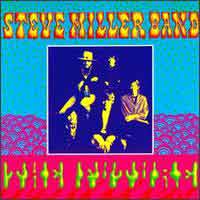 Steve Miller und Boz Scaggs lieferten zusammen mit dem Produzenten
Glyn Johns eines der ersten "Psychedelic Rock"-Alben
ab. U. a. m. Boz Scaggs Klassiker "Baby's Calling Me Home".
Steve Miller und Boz Scaggs lieferten zusammen mit dem Produzenten
Glyn Johns eines der ersten "Psychedelic Rock"-Alben
ab. U. a. m. Boz Scaggs Klassiker "Baby's Calling Me Home".

 Mehr ...
Mehr ...
|
A psychedelic blues rock-out, 1968's Children of the Future marked Steve
Miller's earliest attempt at the ascent that brought him supersonic superstardom.
Recorded at Olympic Studios in London with storied producer Glyn Johns
at the helm, the set played out as pure West Coast rock inflected with
decade-of-love psychedelia but intriguingly cloaked in the misty pathos
of the U.K. blues ethic. Though bandmate Boz Scaggs contributed a few
songs, the bulk of the material was written by Miller while working as
a janitor at a music studio in Texas earlier in the year. The best of
his efforts resonate in a side one free-for-all that launches with the
keys and swirls of the title track and segues smoothly through "Pushed
Me Through It" and "In My First Mind," bound for the epic,
hazy, lazy, organ-inflected "The Beauty of Time Is That It's Snowing,"
which ebbs and flows in ways that are continually surprising. The second
half of the LP is cast in a different light -- a clutch of songs that
groove together but don't have the same sleepy flow. Though it has since
attained classic status -- Miller himself was still performing it eight
years later -- Scaggs' "Baby's Callin' Me Home" is a sparse,
lightly instrumentalized piece of good old '60s San Francisco pop. His
"Steppin' Stone," on the other hand, is a raucous, heavy-handed
blues freakout with a low-riding bass and guitar breaks that angle out
in all directions. And whether the title capitalized at all on the Monkees'
similarly titled song, released a year earlier, is anybody's guess. Children
of the Future was a brilliant debut. And while it is certainly a product
of its era, it's still a vibrant reminder of just how the blues co-opted
the mainstream to magnificent success.
(by Amy Hanson, All
Music Guide)
|
|
| The Zombies: "Odessey And Oracle" (Columbia, April 1968) |
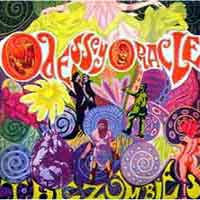 Als
1968 die CBS ODESSEY & ORACLE veröffentlichte, erregte die Platte
erstmal kein Aufsehen. In den USA wurde sogar von einer Veröffentlichung
ganz abgesehen ... bis Al Kooper (damals bei Blood, Sweat &
Tears), begeistert von dem melodiösen Sound dieses Albums, CBS drängte
die LP unbedingt raus zubringen. (Er selbst schrieb fĂ¼r das Plattencover
dann die Liner Notes.) Als dann schlieĂŸlich noch "Time Of The Season",
gesungen vom phantastischen Sänger Colin Blunstone und komponiert
vom Keyboarder Rod Argent, als Single herauskam und Chart-Position
3 in den USA erreichte, erkannte auch die Ă–ffentlichkeit den wahren Geist
dieses Meisterwerkes, welches in seiner harmonischen klangvollen Kraft
und seiner akustischen Präsenz höchstens nur noch von Pet
Sounds getoppt wurde. Als
1968 die CBS ODESSEY & ORACLE veröffentlichte, erregte die Platte
erstmal kein Aufsehen. In den USA wurde sogar von einer Veröffentlichung
ganz abgesehen ... bis Al Kooper (damals bei Blood, Sweat &
Tears), begeistert von dem melodiösen Sound dieses Albums, CBS drängte
die LP unbedingt raus zubringen. (Er selbst schrieb fĂ¼r das Plattencover
dann die Liner Notes.) Als dann schlieĂŸlich noch "Time Of The Season",
gesungen vom phantastischen Sänger Colin Blunstone und komponiert
vom Keyboarder Rod Argent, als Single herauskam und Chart-Position
3 in den USA erreichte, erkannte auch die Ă–ffentlichkeit den wahren Geist
dieses Meisterwerkes, welches in seiner harmonischen klangvollen Kraft
und seiner akustischen Präsenz höchstens nur noch von Pet
Sounds getoppt wurde. |
| Johnny Cash: "... At Folsom Prison" (Columbia, Mai 1968) |
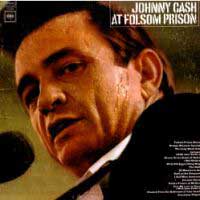 Cash's kommerzieller Durchbruch war dieser Konzertmitschnitt aus dem Knast.
Cash's kommerzieller Durchbruch war dieser Konzertmitschnitt aus dem Knast.
|
| "Quicksilver Messenger Service" (Capitol, Mai 1968) |
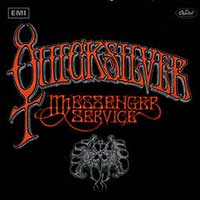 Das
DebĂ¼t der einer Klasseband, die in San Francisco neben den Grateful
Dead und Jefferson Airplane damals leider etwas untergegangen
sind. Zwar nicht so gut wie ihr Meisterwerk "Happy
Trails", aber besser als viele ihrer Versuche in den 70ern. Mit
dem genialen John Cipollina an der Gitarre! Das
DebĂ¼t der einer Klasseband, die in San Francisco neben den Grateful
Dead und Jefferson Airplane damals leider etwas untergegangen
sind. Zwar nicht so gut wie ihr Meisterwerk "Happy
Trails", aber besser als viele ihrer Versuche in den 70ern. Mit
dem genialen John Cipollina an der Gitarre! |
| Scott Walker: "Scott 2" (Philips, Mai 1968) |
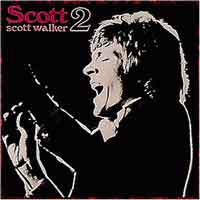

 Mehr ...
Mehr ...
|
Although Walker's second album was his biggest commercial success, actually
reaching number one in Britain, it was not his greatest artistic triumph.
His taste remains eclectic, encompassing Bacharach/David, Tim Hardin,
and of course his main man Jacques Brel (who is covered three times on
this album). And his own songwriting efforts hold their own in this esteemed
company. "The Girls From the Streets" and "Plastic Palace
People" show an uncommonly ambitious lyricist cloaked behind the
over-the-top, schmaltzy orchestral arrangements, one more interested in
examining the seamy underside of glamour and romance than celebrating
its glitter. The Brel tune "Next" must have lifted a few teenage
mums' eyebrows with its not-so-hidden hints of homosexuality and abuse.
Another Brel tune, "The Girl and the Dogs," is less controversial,
but hardly less nasty in its jaded view of romance. Some of the material
is not nearly as memorable, however, and the over-the-top show ballad
production can get overbearing. The album included his first Top 20 U.K.
hit, "Jackie." (by Richie Unterberger, AMG)
|
|
| “Walkers hingebungsvolle Verehrung
für den belgischen Ausnahme-Chansonnier Brel setzte sich mit zwei weiteren
seiner Stücke (`Jackie´, `Next´) auf dem 1968 veröffentlichten
`Scott 2´ fort. Konzept und Mischung ähnelten verblüffend
dem Vorgänger, jedoch gerieten die Klanggemälde in der Umsetzung
noch elegischer.“ (ME/Sounds. 6 von 6 Sternen)
|
|
| „Released in May 1968, `Scott II´ became Walker's
only Number 1 album. Featuring songs written by Jacques Brel (Jackie, Next,
The Girls And The Dogs), Burt Bacharach & Hal David (Windows Of The
World) and Tim Hardin's Black Sheep Boy amongst the album's 12 tracks, Scott
II occupied an influential, if contrasting position towards that year's
summer of love. The influence remains: it's worth noting how more modern
interpretations of Brel, from Bowie and Almond to Momus, rely so heavily
on Walker's master cuts.“ (Q) |
|
| "Fairport Convention" (Polydor, Juni 1968) |
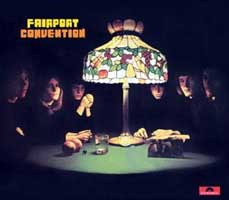 Lost And Found!
Lost And Found!
(28.03.2004) |
| Family: "Music In A Doll's House" (Reprise, Juli 1968) |
 Roger
Chapman gab's auch schon in den 60ern! Lange vor den Shorlists,
lange vor den Streetwalkers.
Mit dabei als Gitarrist und Songwriting-Partner Charlie Whitney,
mit dem er nach dem Ende der Family als Chapman/Whitney-Streetwalkers
weitermachte. Bassisten wurden in der Familie so einige verschlissen,
auf diesem Album, ihrem besten so weit ich das beurteilen kann, ist es
Ric Grech, der danach als einziger "Unbekannter" in der
kurzlebigen "Allstartruppe" Blind Faith (neben Eric
Clapton, Ginger Baker und Steve Winwood) landete. Die
Musik der Family? NatĂ¼rlich wegen der Stimme schon "typisch Chappo",
aber von der Musik her noch nicht so konventionell wie später bei den
Shortlists. Irgendwie war damals ja
"Progressive Rock" schwer angesagt und Family war vorne mit
dabei. Roger
Chapman gab's auch schon in den 60ern! Lange vor den Shorlists,
lange vor den Streetwalkers.
Mit dabei als Gitarrist und Songwriting-Partner Charlie Whitney,
mit dem er nach dem Ende der Family als Chapman/Whitney-Streetwalkers
weitermachte. Bassisten wurden in der Familie so einige verschlissen,
auf diesem Album, ihrem besten so weit ich das beurteilen kann, ist es
Ric Grech, der danach als einziger "Unbekannter" in der
kurzlebigen "Allstartruppe" Blind Faith (neben Eric
Clapton, Ginger Baker und Steve Winwood) landete. Die
Musik der Family? NatĂ¼rlich wegen der Stimme schon "typisch Chappo",
aber von der Musik her noch nicht so konventionell wie später bei den
Shortlists. Irgendwie war damals ja
"Progressive Rock" schwer angesagt und Family war vorne mit
dabei. |
| Nico: "Chelsea Girl" (Polydor/Verve, Juli 1968) |
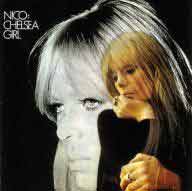 Mit UnterstĂ¼tzung der drei Velvets Lou Reed, John Cale und
Sterling Morrison sowie Jackson
Browne entstand diese wunderbare erste Soloplatte von Christa Päffgen
aus Köln, genannt Nico. Sie nahm drei Lieder von Jackson Browne (u.a.
die erste Version von "These Days") und fĂ¼nf der Velvet-Musiker
(vor allem der Titelsong und das 8minĂ¼tige "It Was A Pleasure Then"
sind bemerkenswert) auf. Dazu kamen Dylans "I'll Keep
It With Mine" und Tim Hardins "Eulogy To Lenny Bruce".
Nicos "Nicht-Gesang" ist beeindruckend, ebenso das Spiel der
drei Velvets. Auch der damals 19jährige Jackson Browne macht keine schlechte
Figur.
Mit UnterstĂ¼tzung der drei Velvets Lou Reed, John Cale und
Sterling Morrison sowie Jackson
Browne entstand diese wunderbare erste Soloplatte von Christa Päffgen
aus Köln, genannt Nico. Sie nahm drei Lieder von Jackson Browne (u.a.
die erste Version von "These Days") und fĂ¼nf der Velvet-Musiker
(vor allem der Titelsong und das 8minĂ¼tige "It Was A Pleasure Then"
sind bemerkenswert) auf. Dazu kamen Dylans "I'll Keep
It With Mine" und Tim Hardins "Eulogy To Lenny Bruce".
Nicos "Nicht-Gesang" ist beeindruckend, ebenso das Spiel der
drei Velvets. Auch der damals 19jährige Jackson Browne macht keine schlechte
Figur.

 Mehr ...
Mehr ...
"Before starting off this particular review, let me
set up a filter. Number one: do NOT buy this album, do NOT read this review
without first having heard The Velvet Underground & Nico. Number two:
do NOT even think of buying this album, do NOT even try reading this review
if you have an inborn allergy towards Nico's voice and general stylistics
with no chance of a cure. To be quite frank, I don't have even the least
idea of why Nico is the most universally despised female performer in rock,
perhaps only sharing the first place with Yoko Ono on occasion, but I already
expressed my wonders, doubts, and what few reasonable arguments I have in
support of the poor girl, in the VU & Nico review, so I'm not going
to repeat myself.
That warning being made, this album absolutely rules, at least, for the
major part of its fourty-six minutes. It didn't even have to grow on me
- I fell in passionate love with it right away. Since it was recorded in
mid-1967, just on the brink of Nico's parting with the Velvets (I'm not
even sure if it was recorded after they went their own ways), the style
is much similar to the one used on VU & Nico, and both Reed and Cale
took part in the recording sessions, the first one contributing guitar and
the second one throwing in some orchestration and 'psychedelic violins'.
Moe Tucker isn't present, because there are actually no drums on the whole
album at all: it's all just folkish acoustic strumming with a few 'modern
classical' minimalistic arrangements. Because of that, the songs might seem
slightly monotonous, but not more so than on your average folk album.
The actual songwriting is more or less equally split in between Cale, Reed,
and, of all things, Jackson Browne; amazingly, Browne's three contributions
to the record are all pleasant, emotional and highly memorable. Nico herself
definitely isn't a songwriter, and her only songwriting credit on here is
the only crying disaster on the album: the eight-minute dissonant horror
of 'It Was A Pleasure Then'. This 'song' looks completely out of place on
the album, because in general, everything on here is melodic, smooth and
pleasant to the ear. When 'Pleasure' suddenly comes on in the middle of
the show, it's like a bucket of cold water: slow discordant mantraic chanting
over a barrage of violin feedback and ugly guitar noises. It's far worse
than even the worst VU excesses, because it's a track that is intentionally
ugly, and ugly in the ugliest sense of the word: using passages that are
plain anti-musical. The track actually cost the album an entire rating point
- please, do me a favour and program it out as soon as you get the album.
Everything else is at the least beautiful and atmospheric, and at best gorgeous
beyond words. Reed and Cale do a great job at providing some of the most
suitable instrumentation for Nico's voice, and often come close to matching
the "icy beauty" of such VU highlights as 'Femme Fatale' or 'I'll
Be Your Mirror'. An obvious highlight, for instance, is 'Chelsea Girls',
a song dealing with the hardship and toil of girls in a public house - hardly
a surprising lyrical matter for Reed - which goes on for seven minutes while
you hardly ever notice it (for contrast, every one of the eight minutes
of 'It Was A Pleasure Then' seems to last longer than Roosevelt's four terms
to me). The flute and orchestration create a sad, melancholic mood, and
the wonderful 'here they come now, see them run now, here they come now
- Chelsea girls' refrain really makes one feel pity for said girls. While
we're at it, I'd like to notice that this was one element sorely lacking
on the Velvets' debut album: they sang so freely and with gusto about "unspoken"
topics, but there was never really any true emotional power in Reed's description
of those topics, rather a peculiar delight and kinky delectation. A song
like 'Chelsea Girls' would have made a great addition to VU & Nico,
yet for some reason Reed and Morrison (the authors) preferred to donate
it to Nico's solo album. Oh well, perhaps they didn't want to sissy up their
image?
Other highlights include Browne's 'The Fairest Of The Seasons', a beautiful
ballad that's as stately and majestic as could be, not to mention a terrific
vocal melody, and Browne's 'These Days', a quirky little folk ditty that
sounds rather humble as compared to the "anthems" on here, but
that's just the song's charm: it's homely, cozy, and very introspective.
And, of course, when you set a humble introspective song like that to the
vocal chords of a German singerine, thus combining an inborn "goth
grandeur" with typical Anglo-Saxon "debasedness", the contrast
and interaction of the two moods is amazing; you'll hardly hear anything
like that on any other record in existence. Say, perhaps you should buy
this album after all... even if you hate Nico's voice?
I won't be naming the other songs (okay, just two - there's a very nice
cover of Dylan's 'I'll Keep It With Mine' here, too, and she also gets a
take on Tim Hardin's 'Eulogy To Lenny Bruce'; apparently, Nico was a big
Lenny Bruce fan), but suffice it to say that while they don't exactly match
the power and emotional force of the ones I already listed, none of them
are bad, and that wonderful "German goth vs. American folk" atmosphere
is omnipresent. Apart from the murky horror of 'It Was A Pleasure', then,
and the unnecessary Nico-mystifying liner notes by Pat Patterson, this is
a true minor miracle of a record, even if it's hardly "rock music"
or "folk music" in any traditional sense. Oh, and, by the way,
it also seems to be the most accessible of all Nico albums (at least, all
the good and respected ones), so it also looks like a good way to start
with the gal. That is, if you don't have any biases towards German voices."
(from George
Starostin's Reviews) |
|
| The Byrds: "Sweetheart Of The Rodeo" (Columbia, Aug. 1968) |
 Auf diesem Album konvertierten die Byrds zur Countrymusik, was sicherlich
auf Gram Parsons Einfluss zurĂ¼ckzufĂ¼hren ist, der allerdings
nach dieser Platte die Band bereits wieder verlieĂŸ und mit Chris
Hillman die Flying Burrito
Brothers grĂ¼ndete. Zu den Highlights gehören Parsons "Hickory
Wind", Dylans "You Ain't Goin' Nowhere" und der
Soulklassiker "You Don't Miss Your Water". Grams Leadvocals
sind leider alle aus "kommerziellen GrĂ¼nden" mit Roger McGuinns
Gesängen ausgetauscht worden. Die Ursprungsversionen kann man auf diversen
Samplern nachhören.
Auf diesem Album konvertierten die Byrds zur Countrymusik, was sicherlich
auf Gram Parsons Einfluss zurĂ¼ckzufĂ¼hren ist, der allerdings
nach dieser Platte die Band bereits wieder verlieĂŸ und mit Chris
Hillman die Flying Burrito
Brothers grĂ¼ndete. Zu den Highlights gehören Parsons "Hickory
Wind", Dylans "You Ain't Goin' Nowhere" und der
Soulklassiker "You Don't Miss Your Water". Grams Leadvocals
sind leider alle aus "kommerziellen GrĂ¼nden" mit Roger McGuinns
Gesängen ausgetauscht worden. Die Ursprungsversionen kann man auf diversen
Samplern nachhören.

 Mehr ...
Mehr ...
| "The first "official" country-rock album,
though really, it was simply a masterful country album, by a rock band.
As the story goes, Parsons pretty much muscled his way into LA's then-ascendant
folk-rock band, and swiftly remade them into Nudie suit-wearing space cowboy,
hippie-billies... which is to say, into his band. Naturally there was resentment
within the group, and Parsons was eventually given the boot, but not before
they made this wonderful, landmark album. Gram provided most of the arrangements
and repertoire, including his own classic ballad, "Hickory Wind",
and oldies such as the Louvin's "Christian Life". Because he was
under contract to another label, though, the producers at Columbia stripped
Parsons' vocal tracks off the album, and replaced them with lead vocals
by Roger McGuinn and Chris Hillman. Recent CD reissues have gone back and
(partially) re-created the album as it was originally recorded." |
|
|
On release, this bold experiment in Nashville classicism was shunned
by rock fans and country purists alike. But rural American song had been
central to the Byrds' folk-rock sound; here, driven by junior Byrd Gram
Parsons, the band highlighted that connection, dressing Bob Dylan and
Merle Haggard songs in steel guitar and rock & roll drive, setting
the stage for country rock. Legal hassles forced the removal of most of
Parsons' lead vocals from the '68 LP (they're restored on CD), and he
quit before it came out. But he left signs of his short, glorious future
in his originals "Hickory Wind" and "One Hundred Years
From Now." (Rolling Stone)
Total album sales: Under 500,000
Peak chart position: 77
|
|
|
The Byrds' Sweetheart of the Rodeo was not the first important country-rock
album (Gram Parsons managed that feat with The International Submarine
Band's debut Safe at Home), and The Byrds were hardly strangers to country
music, dipping their toes in the twangy stuff as early as their second
album. But no major band had gone so deep into the sound and feeling of
classic country (without parody or condescension) as the Byrds did on
Sweetheart; at a time when most rock fans viewed country as a musical
"L'il Abner" routine, the Byrds dared to declare that C&W
could be hip, cool, and heartfelt. Though Gram Parsons had joined the
band as a pianist and lead guitarist, his deep love of C&W soon took
hold, and Roger McGuinn and Chris Hillman followed his lead; significantly,
the only two original songs on the album were both written by Parsons
(the achingly beautiful "Hickory Wind" and "One Hundred
Years from Now"), while on the rest of the set classic tunes by Merle
Haggard, the Louvin Brothers, and Woody Guthrie were sandwiched between
a pair of twanged-up Bob Dylan compositions. While many cite this as more
of a Gram Parsons album than a Byrds set, given the strong country influence
of McGuinn and Hillman's later work, it's obvious Parsons didn't impose
a style upon this band so much as he tapped into a sound that was already
there, waiting to be released. If the Byrds didn't do country-rock first,
they did it brilliantly, and few albums in the style are as beautiful
and emotionally affecting as this. (by Mark Deming, AMG)
|
|
| The Grateful Dead: "Anthem Of The Sun" (Warner, Aug. 1968) |
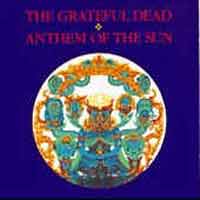 Auf
diesem Album haben die Dead versucht, ihre Stärke als Live-Jam-Band in
eine Studioproduktion einzubringen. Dazu wurden Livebänder mit Studioaufnahmen
gemischt. Der von Warner angeheuerte teure Produzent David Hassinger
(er hat -glaub ich- auch mit den Stones aufgenommen) muss dabei fast verzweifelt
sein (diese unprofessionellen Hippies!). Hier ein Tipp: es gibt aus der
Videoreihe "Classic Rock Albums" (oder so ähnlich) eine Folge
der Dead mit dem Namen "From Anthem To Beauty", die sich mit
der Entstehung der Alben "Anthem Of The Sun" und "American
Beauty" beschäftigt. Total spannend zu verfolgen. Ansonsten gefallen
mir die reinen Livealben (z.B. "Live/Dead"
oder "Europe 72") und
die späteren songorientierten Studioalben ("Workingman's
Dead" und "American
Beauty") besser als das FrĂ¼hwerk. Von den zum Teil kryptischen
Songs hat sich nur die Weir/Kreutzmann-Komposition "The Other One"
einen wichtigen Platz im Live-Repertoire der Band erobert. Ach ja- erstmalig
treten Robert Hunter als Texter und Mickey Hart als zweiter
Trommler in Erscheinung. Auf
diesem Album haben die Dead versucht, ihre Stärke als Live-Jam-Band in
eine Studioproduktion einzubringen. Dazu wurden Livebänder mit Studioaufnahmen
gemischt. Der von Warner angeheuerte teure Produzent David Hassinger
(er hat -glaub ich- auch mit den Stones aufgenommen) muss dabei fast verzweifelt
sein (diese unprofessionellen Hippies!). Hier ein Tipp: es gibt aus der
Videoreihe "Classic Rock Albums" (oder so ähnlich) eine Folge
der Dead mit dem Namen "From Anthem To Beauty", die sich mit
der Entstehung der Alben "Anthem Of The Sun" und "American
Beauty" beschäftigt. Total spannend zu verfolgen. Ansonsten gefallen
mir die reinen Livealben (z.B. "Live/Dead"
oder "Europe 72") und
die späteren songorientierten Studioalben ("Workingman's
Dead" und "American
Beauty") besser als das FrĂ¼hwerk. Von den zum Teil kryptischen
Songs hat sich nur die Weir/Kreutzmann-Komposition "The Other One"
einen wichtigen Platz im Live-Repertoire der Band erobert. Ach ja- erstmalig
treten Robert Hunter als Texter und Mickey Hart als zweiter
Trommler in Erscheinung. |
| Jefferson Airlane: "Crown Of Creation" (RCA/Grunt, Sept. 1968) |
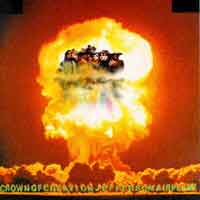 Zwar
ohne Hits, aber mit "Triad", David Crosbys Song Ă¼ber eine Dreiecksgeschichte,
den Roger McGuinn bei den Byrds gerĂ¼chteweise nicht spielen wollte. Dass
Crosby danach die Byrds verlieĂŸ und mit seinen neuen Partnern Stills,
Nash und Young das Lied sehr erfolgreich spielen konnte, ist eine andere
Geschichte. Hier wird die Nummer aber von einer Frau (Grace Slick) gesungen,
was das ganze fĂ¼r viele puritanische Zeitgenossen sogar noch provokanter
machte. Zwar
ohne Hits, aber mit "Triad", David Crosbys Song Ă¼ber eine Dreiecksgeschichte,
den Roger McGuinn bei den Byrds gerĂ¼chteweise nicht spielen wollte. Dass
Crosby danach die Byrds verlieĂŸ und mit seinen neuen Partnern Stills,
Nash und Young das Lied sehr erfolgreich spielen konnte, ist eine andere
Geschichte. Hier wird die Nummer aber von einer Frau (Grace Slick) gesungen,
was das ganze fĂ¼r viele puritanische Zeitgenossen sogar noch provokanter
machte. |
| "David Ackles" (Elektra, Okt. 1968) |
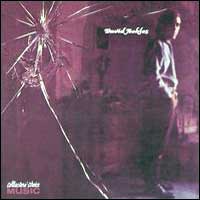 Ein eher unbekannter Singer/Songwriter aus den Spät60ern, den man - wenn
Ă¼berhaupt - nur als Komponist des Julie Driscoll/Brian Auger-Hits
"Road To Cairo" kennt, der sich auf diesem
Album befindet und auch fĂ¼r mich der Grund war, vor einiger Zeit die CD
zu kaufen. Wie klingt das Ganze nun? Man könnte sagen: "typisch Elektra
ca. 66-69"! Das Label, welches auch heutzutage als Unterabteilung
von AOL/Time/Warner noch immer existiert und mit Bands wie Metallica
Geld scheffelt, war damals eher ein Folk/Singer/Songwriter-Label und ziemlich
hip: dabei waren, mit durchaus vergleichbarer Musik u. a.: Tim
Buckley, Fred Neil, Mickey Newbury,
Tom Rush und David Blue. Und Rockband wie die Doors
(noch) die Ausnahme.
Ein eher unbekannter Singer/Songwriter aus den Spät60ern, den man - wenn
Ă¼berhaupt - nur als Komponist des Julie Driscoll/Brian Auger-Hits
"Road To Cairo" kennt, der sich auf diesem
Album befindet und auch fĂ¼r mich der Grund war, vor einiger Zeit die CD
zu kaufen. Wie klingt das Ganze nun? Man könnte sagen: "typisch Elektra
ca. 66-69"! Das Label, welches auch heutzutage als Unterabteilung
von AOL/Time/Warner noch immer existiert und mit Bands wie Metallica
Geld scheffelt, war damals eher ein Folk/Singer/Songwriter-Label und ziemlich
hip: dabei waren, mit durchaus vergleichbarer Musik u. a.: Tim
Buckley, Fred Neil, Mickey Newbury,
Tom Rush und David Blue. Und Rockband wie die Doors
(noch) die Ausnahme.

 Mehr ...
Mehr ...
|
Das Debutalbum von 1968. Ganz ungewöhnlich für die damalige
Zeit: Der Mann hatte die 30 schon überschritten. Was, in punkto Reife,
dem Werk sicherlich zugute kam. Die 5 Musiker stammten von Iron Butterfly,
Buffalo Springfield und Electric Flag und sorgten (stärker als bei
den nachfolgenden LPs) wenigstens bei einigen Stücken für einen
gewissen jedoch nie dominanten Rockeinfluß, im Sinne von „Singer-Songwriter-Rock“.
Aber selbst dann fasziniert eine ganz eigene besondere songschreiberische
und melodische Note, unorthodox, ungebunden. Psychedelische Untertöne
stehen neben klassischen (Piano-)Balladen, ein markanter tragender Baß
neben schwellenden oder dezenten Orgelflächen, dazu kommen filigrane
frei schwebende Gitarren (etwas ähnlich dem sanften Tim Buckley).
Die fast durchweg langsame, oft leise Musik (häufiger ohne Drums)
läßt ab und zu an Zeitgenossen wie Fred Neil, Randy Newman,
Nick Drake, Scott Walker (oder eben Tim Buckley) denken, behält aber
immer ihre Eigenständigkeit. Großartig!
(Glitterhouse)
|
|
|
Ackles' self-titled debut LP introduced a singer/songwriter quirky even
by the standards of Elektra records, possibly the most adventurous independent
label of the 1960s. Ackles was a pretty anomalous artist of his time,
with a low, grumbling voice that was uncommercial but expressive, and
similar to Randy Newman's. As a composer, Ackles bore some similarities
to Newman, as well in his downbeat eccentricity and mixture of elements
from pop, folk, and theatrical music. All the same, this impressive maiden
outing stands on its own, though comparisons to Brecht/Weill (in the songwriting
and occasional circus-like tunes) and Tim Buckley (in the arrangements
and phrasing) hold to some degree too. This is certainly his most rock-oriented
record, courtesy of the typically tasteful, imaginative Elektra arrangements,
particularly with Michael Fonfara's celestial organ and the ethereal guitar
riffs (which, again, recall those heard on Buckley's early albums). As
a songwriter, Ackles was among the darkest princes of his time, though
the lyrics were delivered with a subdued resignation that kept them from
crossing the line to hysterical gloom. "The Road to Cairo,"
covered by Julie Driscoll, Brian Auger, and the Trinity, is probably the
most famous song here. But the others are quality efforts as well, whether
the epics tell of religious trial, as in "His Name Is Andrew,"
or the mini-horror tale of revisiting an old home in "Sonny Come
Home." (by Richie Unterberger (AMG))
|
|
| The Beau Brummels: "Bradley's Barn" (Warner, Okt. 1968) |
|
 Kommerziell hat Warner bei der Band falsch gemacht, was man nur falsch
machen konnte, als man sie 1966 zusammen mit ihrem alten Label "Ă¼bernahm":
Zwar standen auf der Habenseite ein toller Sänger (Sal Valentino),
gutes eigenes Songmaterial (von Gitarrist Ron Elliott) und ein
den Beatles und den Byrds nicht unähnlicher Sound, aber
man lieĂŸ sie zuerst auf "Beau Brummels '66" die Charthits
anderer Leute nachspielen (das war den Freunden anspruchsvoller Rockmusik
zu blöd), um dann in 1967 im anderen Extrem ein anspruchsvolles Konzeptalbum
mit tollen Orchesterarrangements aufzunehmen ("Triangle"
vom Resttrio ist eine tolle Platte, aber eben nichts fĂ¼r die Freunde
der Hitparade). Zum "Karriereende" ging dann das Restduo Valentino/Elliott
mit Produzent Lenny Waronker nach Nashville und nahmen unter
den dort Ă¼blichen Live-im-Studio-Bedingungen diese wunderbare Country-Rockplatte
auf. Zeitlich zwar nach "Sweetheart Of The
Rodeo", aber eben vor "Workingman's
Dead" und "American
Beauty" der San-Francisco-Kollegen Grateful Dead entstanden!
Das war natĂ¼rlich nix fĂ¼r die Hippies - und auch nix fĂ¼r die Rednecks.
Danach war Schluss, obwohl Elliott 1970 noch ein schönes Soloalbum aufnahm
("The Candlestickmaker")
und auch mal bei Van Morrison,
Randy Newman und den Everly
Brothers mitspielte. Sal Valentino sang danach bei der Band
Stoneground, die auch toll sein sollen und deren CDs genauso
wie die der Brummels und anderer vergessener Warner/Elektra-KĂ¼nstler
(David Ackles, The
Association, etc) bei Collector's Choice wiederveröffentlicht
wurden. Ich glaube, ich weiĂŸ, was ich mir demnächst bestellen muss...
Kommerziell hat Warner bei der Band falsch gemacht, was man nur falsch
machen konnte, als man sie 1966 zusammen mit ihrem alten Label "Ă¼bernahm":
Zwar standen auf der Habenseite ein toller Sänger (Sal Valentino),
gutes eigenes Songmaterial (von Gitarrist Ron Elliott) und ein
den Beatles und den Byrds nicht unähnlicher Sound, aber
man lieĂŸ sie zuerst auf "Beau Brummels '66" die Charthits
anderer Leute nachspielen (das war den Freunden anspruchsvoller Rockmusik
zu blöd), um dann in 1967 im anderen Extrem ein anspruchsvolles Konzeptalbum
mit tollen Orchesterarrangements aufzunehmen ("Triangle"
vom Resttrio ist eine tolle Platte, aber eben nichts fĂ¼r die Freunde
der Hitparade). Zum "Karriereende" ging dann das Restduo Valentino/Elliott
mit Produzent Lenny Waronker nach Nashville und nahmen unter
den dort Ă¼blichen Live-im-Studio-Bedingungen diese wunderbare Country-Rockplatte
auf. Zeitlich zwar nach "Sweetheart Of The
Rodeo", aber eben vor "Workingman's
Dead" und "American
Beauty" der San-Francisco-Kollegen Grateful Dead entstanden!
Das war natĂ¼rlich nix fĂ¼r die Hippies - und auch nix fĂ¼r die Rednecks.
Danach war Schluss, obwohl Elliott 1970 noch ein schönes Soloalbum aufnahm
("The Candlestickmaker")
und auch mal bei Van Morrison,
Randy Newman und den Everly
Brothers mitspielte. Sal Valentino sang danach bei der Band
Stoneground, die auch toll sein sollen und deren CDs genauso
wie die der Brummels und anderer vergessener Warner/Elektra-KĂ¼nstler
(David Ackles, The
Association, etc) bei Collector's Choice wiederveröffentlicht
wurden. Ich glaube, ich weiĂŸ, was ich mir demnächst bestellen muss...
(12.06.2005)
Auch Stoneground stehen im Plattenregal und machen sich dort
gut! Mehr dazu unter Lost &
Found!
(30.07.2005)

 Mehr ...
Mehr ...
|
`68er Country-Klassiker, den Valentino/Elliott in Nashville mit Cats
wie Jerry Reed und Kenny Buttrey einspielten. Weniger mysteriöse
Psychedelia à la „Triangle“, eher von „Sweethearts
Of The Rodeo“ beeinflußter, ganz exzellenter Country-Rock.
(Glitterhouse)
|
|
|
After taking the Beau Brummels to the pop/folk psychedelic edge, producer
Lenny Waronker took the band to Nashville, literally. Possibly influenced
by the Byrds Sweetheart experiments, the group (now down to just Sal Valentino
on vocals and Ron Elliott on guitars) wedded with Nashville's finest,
including guitarist Jerry Reed and drummer Kenneth A. Buttrey, both veterans
of Dylan's Nashville sessions. These players were not just good musicians,
but smart musicians, easily embellishing the Elliott/Valentino duo as
if they had been playing with the two for years, not days. The resulting
masterpiece, no doubt due to the awesome Brummels original songs (especially
"Cherokee Girl," "Turn Around," and "Deep Water"),
is a virtual tapestry in country and rock.
(by Matthew Greenwald, All
Music Guide)
|
|
| "Caravan" (MGM, Okt. 1968) |

(25.01.2009)

 Mehr ...
Mehr ...
For their first album, Caravan was surprisingly strong. While steeped in the same British psychedelia that informed bands such as Love Children, Pink Floyd, and Tomorrow, Caravan relates a freedom of spirit and mischief along the lines of Giles, Giles & Fripp or Gong. The band's roots can be traced to a British blue-eyed soul combo called the Wilde Flowers. Among the luminaries to have passed through this Caravan precursor were Robert Wyatt, Kevin Ayers, and Hugh Hopper and Brian Hopper (pre-Soft Machine, naturally). By the spring of 1968, Caravan had settled nicely into a quartet consisting of Pye Hastings (guitar/bass/vocals), Richard Coughlan (drums), David Sinclair (organ/vocals), and Richard Sinclair (bass/guitar/vocals). Inspired by the notoriety and acclaim that Soft Machine encountered during the burgeoning days of London's underground scene, Caravan began a residency at the Middle Earth club. Additionally, the band was shopping a homemade demo tape around to local record companies. Before long, entrepreneur Tony Cox worked out a deal for them to record on the newly founded U.K. division of the Verve label. Caravan's self-titled debut is equally as inventive and infinitely more subtle than the Soft Machine's Volume One or Pink Floyd's Piper at the Gates of Dawn. Two of the album's best tunes — the ethereal "Place of My Own" was backed with the dreamlike "Magic Man" — were issued as the band's first single. Those tracks accurately exemplify the subtle complexities that Caravan would hone to great effect on later recordings. The same can also be said for album cuts such as "Love Song With Flute" and the extended nine-minute "Where but for Caravan Would I?" The latter title aptly exemplifies Caravan's decidedly less than turgid attitude toward themselves — a refreshing contrast from the temperamental and serious Art School approach adopted by Pink Floyd and the Moody Blues. The mono and stereo mixes of the long-player are striking in their disparities. The stereo mix is at times opaque and virtually swallows the vocals most specifically on the tracks "Policeman" and "Grandma's Lawn." Otherwise, there are numerous additional nuances that discern the two. The single version of "Hello Hello" is also included as a bonus. This track was the follow-up 45 to "Place of My Own" and would appear in a slightly different form on their next LP, If I Could Do It All Over Again, I'd Do It All Over You. Potential consumers should note that the sound quality on this package is indescribably better than the HTD Records 1996 CD pressing.
(by Lindsay Planer, All Music Guide)
|
| Doug Dillard & Gene Clark: "The Fantastic Expedition Of Dillard & Clark" (A&M, Okt. 1968) |
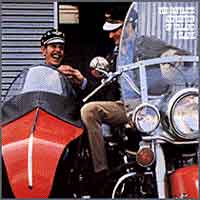 Bei
den Byrds war Gene Clark fĂ¼r die besten Songs verantwortlich
("Eight Miles High", "Feel A Whole Lot Better"),
durfte im Schatten von Roger McGuinn aber meist nur Chorstimme singen
und das Tamburine schwingen. Auf dieser Platte tat er sich mit dem
Banjospieler Doug Dillard zusammen. Mit dabei war auch der spätere
"Burrito-Brother" und "Eagle"
Bernie Leadon. Bei
den Byrds war Gene Clark fĂ¼r die besten Songs verantwortlich
("Eight Miles High", "Feel A Whole Lot Better"),
durfte im Schatten von Roger McGuinn aber meist nur Chorstimme singen
und das Tamburine schwingen. Auf dieser Platte tat er sich mit dem
Banjospieler Doug Dillard zusammen. Mit dabei war auch der spätere
"Burrito-Brother" und "Eagle"
Bernie Leadon. |
| The Incredible String Band: "Wee Tam & The Big Huge" (Elektra, Okt. 1968) |
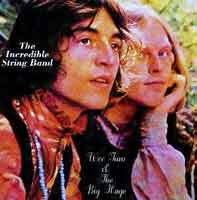 Im Oktober 1968 veröffentlichte unser Duo sogar zwei Alben gleichzeitig,
die es dann teilweise auch als Doppelalbum zusammen zu kaufen gab. Sehr
verwirrend.
Im Oktober 1968 veröffentlichte unser Duo sogar zwei Alben gleichzeitig,
die es dann teilweise auch als Doppelalbum zusammen zu kaufen gab. Sehr
verwirrend.

 Mehr ...
Mehr ...
This album was originally issued in the Incredible String Band's native England as the first in a two-LP collection with a companion disc entitled The Big Huge. However, stateside distributor Elektra Records decided to present them as two separate works. This version of the ISB includes founding members Robin Williamson (organ, bass, flute, guitar, percussion, piano, violin, drums, harpsichord, kazoo, whistle, sarangui, gimbri, and Irish harp) and Mike Heron (organ, bass, guitar, harmonica, harpsichord, sitar, and washboard) as well as their significant others, Christina "Liquorice" McKechnie (vocals, percussion, and Irish harp) and Rose Simpson (violin, bass, and vocals). At this point — mid-1968 — the quartet was continuing to experiment with a blend of folk music(s) from both sides of the Atlantic. They were also adding elements of psychedelia throughout. However, rather than the typical electric guitars and oftentimes nonsensical lyrics, the ISB were decidedly more insular. The double lead vocals on "Job's Tears" as well as the delicate minor-chord cacophonies and random woodwinds during "Beyond the Sea" are infinitely more subtle yet no less trippy than most anything the band had tried previously. "The Half-Remarkable Question" is a musical enigma, replete with a bouncy sitar-driven melody. This inevitably reminds the listener of the genuine breadth and scope of both Heron and Williamson's multi-instrumental talents and seeming mastery of all things stringed. There are also a few ISB classics included on Wee Tam — such as the acoustic Appalachian sound of Heron's "Log Cabin in the Sky" as well as the innocuous love song "You Get Brighter," both of which remained at the heart of the ISB canon for decades to come. Unlike the excessive and scattered material that would accompany the quartet's interests [read: obsession] in Scientology during the ensuing years, Wee Tam and The Big Huge are charming and among the most representative discs from this incarnation of the ISB.
(by Lindsay Planer, All Music Guide)

 Mehr ...
Mehr ...

Although issued as a separate release in the U.S., The Big Huge is actually the second-disc counterpart of Wee Tam. The set appeared as a two-LP package throughout the rest of the world. Understandably, the albums are very similar in structure and content. This quartet incarnation of the Incredible String Band featured primary songwriters Robin Williamson and Mike Heron as well as their significant others, Christina "Liquorice" McKechnie and Rose Simpson. The ISB's tradition of quirky, and at times atonal, acoustic material is well served by the nine compositions on this platter. The lengthy opening track, "Maya," foreshadows their less-focused upcoming works I Looked Up and U. Although there are a few moments of brilliant playing, the ambling nature of the song overall makes for difficult consumption during a single sitting. The remainder of the record — while similar in unfettered spirit — contains decidedly more cohesive pieces, a few of which are among the ISB's most lauded compositions. These include the pastoral "Greatest Friend" and a dirge-like "The Circle Is Unbroken." "Lordly Nightshade" contains a few 20th century references — such as Hitler, who is likewise mentioned in "Maya." The minstrel storytelling quality adds an ethereal sense to the darkly toned subject matter. The vocal harmonies throughout The Big Huge are among the quartet's finest — most notably the four-part division on "The Mountain of God" and the deceptively simple and silly "Cousin Caterpillar." After several years out of print, Collectors' Choice Music reissued both Wee Tam and The Big Huge as a double-CD set — including the original LP graphics and lyrics.
(by Lindsay Planer, All Music Guide)
|
| Steve Miller Band: "Sailor" (Capitol, Okt. 1968) |
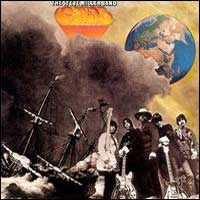 Mit dem zweiten Album innerhalb eines Jahres gibt es eine weitere Steigerung.
Man kann sogar sagen, dass die Band bereits vor Pink Floyd "Pink
Floyd-Musik" gespielt hat. AuĂŸerdem werden die eigenen Blueswurzeln
gepflegt (Jimmy Reeds "You're So Fine"), Pophits gemacht
("Living In The U.S.A.") und Johnny "Guitar" Watsons
"Gangster Of Love" der Welt näher gebracht. Bestes Lied aber
ist die Hippie-Ballade "Dear Mary".
Mit dem zweiten Album innerhalb eines Jahres gibt es eine weitere Steigerung.
Man kann sogar sagen, dass die Band bereits vor Pink Floyd "Pink
Floyd-Musik" gespielt hat. AuĂŸerdem werden die eigenen Blueswurzeln
gepflegt (Jimmy Reeds "You're So Fine"), Pophits gemacht
("Living In The U.S.A.") und Johnny "Guitar" Watsons
"Gangster Of Love" der Welt näher gebracht. Bestes Lied aber
ist die Hippie-Ballade "Dear Mary".

 Mehr ...
Mehr ...
Most definitely a part of the late-'60s West Coast psychedelic blues revolution that was becoming hipper than hip, Steve Miller was also always acutely aware of both the British psychedelic movement that was swirling in tandem and of where the future lay, and how that would evolve into something even more remarkable. The result of all those ideas, of course, came together on 1968's magnificent Sailor LP. Speaking to Goldmine magazine in 2002, Miller reiterated that he was always aware of forward thinking: "It's amazing what the breakthroughs are, and the quality is absolutely better and you don't have the digital/analog argument anymore about what sounds the best. It's all new. And now anybody in the world can do what I wanted to do so badly when I got my deal with Capitol Records and got to finally go into a recording studio." What was begun on Children of the Future is more fully realized on Sailor, most notably on the opening "Song for Our Ancestors," which begins with a foghorn and only gets stranger from there. Indeed, the song precognizes Pink Floyd's 1971 opus "Echoes" to such an extent that one wonders how much the latter enjoyed Miller's own wild ride. Elsewhere, the beautiful, slow "Dear Mary" positively shimmers in a haze of declared love, while the heavy drumbeats and rock riffing guitar of "Living in the U.S.A." are a powerful reminder that the Steve Miller Band, no matter what other paths they meandered down, could rock out with the best of them. And, of course, this is the LP that introduced many to the Johnny "Guitar" Watson classic "Gangster of Love," a song that would become almost wholly Miller's own, giving the fans an alter ego to caress long before "The Joker" arose to show his hand. Rounding out Miller's love of the blues is an excellent rendering of Jimmy Reed's "You're So Fine." At their blues-loving best, Sailor is a classic Miller recording and a must-have -- especially for the more contemporary fan, where it becomes an initiation into a past of mythic proportion
(by Amy Hanson, All Music Guide)
|
| The Beatles: "White Album" (EMI/Parlophone, Nov. 1968) |
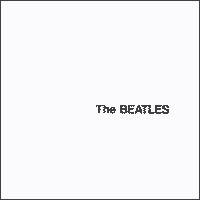 Was soll man sagen? Das letzte Meisterwerk der Beatles, besser als die
danach noch folgenden "Let It Be" und "Abbey Road",
obwohl auch die ihre Momente haben.
Was soll man sagen? Das letzte Meisterwerk der Beatles, besser als die
danach noch folgenden "Let It Be" und "Abbey Road",
obwohl auch die ihre Momente haben.

 Mehr ...
Mehr ...
"The legacy of The Beatles has become so totally encrusted
with cultural effluvia that it's hard to even hear them above the seismic
ripples they sent beaming across the decades.
If you were scoring them solely on their influence then they've undoubtedly
been one of the worst things that ever happened to rock, their name being
used to justify and embolden countless anaemic indie drips.
Yet it's hardly their fault; in the years since they split, The Beatles
have been reduced from being seen as a group who almost single-handedly
ripped the top off rock music - exposing it to so many disparate and enlivening
influences (Indian ragas, musique concrete) - to a one-dimensional caricature,
mere dab hands at catchy tunes.
Therefore every band of half-wits that sails out of the NME's wazoo is immediately
hailed as next in line for The Beatles' throne simply by dint of being capable
of writing something that sounds like a song.
Take time to really listen to The White Album and it's immediately clear
that barely a handful of groups have even begun to engage with The Beatles'
legacy. Listen to the endless circular logic of McCartney's basslines, the
lopsided clunk of Dear Prudence, the barbed wire ferocity of Helter Skelter.
The Beatles were always creatively restless and The White Album sees them
pushing further into alien territory. But back then every new Beatles record
was a trip; the faceless dross that followed them feels more like a sedative.
heavy." |
|
| Van Morrison: "Astral Weeks" (Warner, Nov. 1968) |
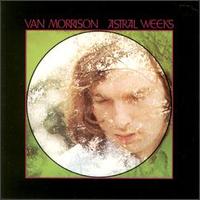 Nach der Zeit mit Them und nicht ganz glĂ¼cklichen Versuchen als
Solist (später als "T.B. Sheets" und unter anderen Namen immer
wieder mehr oder weniger seriös veröffentlicht) gelang ihm mit dieser
Platte der kĂ¼nstlerische Durchbruch. Folk, Blues und Jazz verbinden
sich zu einer neuen Ă„sthetik. Neben dem Titelsong sind besonders "Madame
George" und "Sweet Thing" hervorzuheben. In der Band
sind besonders die Jazzmusiker Jay Berliner (Gitarre), Richard
Davis (Kontrabass) und Connie Kay (Schlagzeug) zu erwähnen.
Nach der Zeit mit Them und nicht ganz glĂ¼cklichen Versuchen als
Solist (später als "T.B. Sheets" und unter anderen Namen immer
wieder mehr oder weniger seriös veröffentlicht) gelang ihm mit dieser
Platte der kĂ¼nstlerische Durchbruch. Folk, Blues und Jazz verbinden
sich zu einer neuen Ă„sthetik. Neben dem Titelsong sind besonders "Madame
George" und "Sweet Thing" hervorzuheben. In der Band
sind besonders die Jazzmusiker Jay Berliner (Gitarre), Richard
Davis (Kontrabass) und Connie Kay (Schlagzeug) zu erwähnen.

 Mehr ...
Mehr ...
»Astral Weeks« ist das zweite Soloalbum des nordirischen Musikers Van Morrison, mit dem der ehemalige Them-Sänger nach der Auflösung der Band seine Solokarriere weiter ausprägte.
Aufgenommen wurde die acht Songs umfassende Platte innerhalb von nur zwei Tagen im September und Oktober 1968 in den Century Sound Studios in New York. Unterstützung erhielt Van Morrison dabei von dem Gitarristen Jay Berliner, dem Bassisten Richard Davis, dem Perkussionisten Warren Smith und dem Schlagzeuger Connie Kay. Es ist das erste Album, das der Sänger beim Label Warner Brothers produzierte.
»Astral Weeks« ist eine Mischung aus Folk, Blues und Jazz. Es gehört nicht zu den erfolgreichsten Van-Morrison-Alben, hat jedoch bis heute bei seinen Fans Kultstatus erlangt.
2015 erscheint nun eine Neuauflage des Albums, für die alle acht Songs komplett neu gemastert wurden. Die Expanded Version der Platte enthält zudem vier weitere, bisher nie veröffentlichte Tracks. Dazu gehören eine lange Version von »Ballarina«, eine vibraphonlastige Variante von »Madame George«, die ungekürzte Version von »Slim Slow Slider« sowie der erste Take von »Beside You«.
Mit »Astral Weeks« erscheint ein echter Leckerbissen für Van-Morrison-Fans. Ein Kultalbum in neuer Tonqualität, mit bisher nie gehörten Aufnahmen des legendären Musikers in der Expanded Edition.
»Nun erscheint das Meisterwerk in einem neuen Remaster in kristallklarem Sound. Als Bonus gibt es vier bislang unveröffentlichte Takes, darunter die längere, ungeschnittene Version von “Slim Slow Slider” sowie einen Mix von “Madame George” ohne Streicher.«
(Good Times, Dezember 2015 / Januar 2016)
"Astral Weeks was one of Van Morrison's first solo albums after he quit Them and it still stands as a great anomaly in his back catalogue. It's a staggering work, filled with a great, compassionate sorrow for the world that's cut with an ecstatic mysticism. His lyrics are visionary and deeply sensual, garbled passages of word-sounds that convey more via their movement and phrasing than any straight reading ever could. His band are phenomenal, although rumours still persist that - due to the fact that Morrison couldn't be in the same room with any of them - they all overdubbed their parts later, the core of the songs being Morrison's solo guitar and vocal track. Either way, the arrangements are glorious. There's a lightness of touch and a melodic freedom that's fairly jazzy, especially in guitarist Jay Berliner's quicksilver leads, an echo of his work with Mingus on The Black Saint and The Sinner Lady. The vibes, flute and soprano saxophone give the tracks an organic quality as they expand and contract like breath. The title track is a hallucinatory regression, via aerial views of heavy industry, visitations from dead bluesmen and resurrection through love, with Richard Davis' acoustic bass plotting little yelps of joy throughout. Still, Sweet Thing is the stand-out, with Morrison surrendered to love and vowing never to grow so old again. He was 23."
"This is music of such enigmatic beauty that, thirty-five years after its release, Astral Weeks still defies easy, admiring description. There was no precedent for it in Van Morrison's previous vocal and songwriting success: the bright, rolling pop of his 1967 Top Ten hit, "Brown Eyed Girl"; his earlier spell as the leader of Irish R&B punks Them and writer of the garage-rock standard "Gloria." And Morrison -- a notoriously private man for whom singing and songwriting have long been a form of emotional armor as well as release -- never 0sounded as warm and ecstatic, more sensual and vulnerable, as he did on Astral Weeks. It was, in part, the sound of sweet relief. Morrison was newly signed to artist-friendly Warner Bros., after a rough ride with his previous U.S. label, Bang, when he made Astral Weeks in the summer of 1968. This was to be his first full-fledged solo album, and he used the opportunity to explore the physical and dramatic range of his voice in his extended poetic-scat singing in "Beside You" and "Ballerina." Morrison also turned his back on straight pop-song structure, setting these hallucinatory reveries on his native Belfast (the daydream memoir "Cypress Avenue," the hypnotic portrait of "Madame George") to wandering melodies connecting the earthy poetry in Celtic folk and American R&B. The crowning touch was the superior jazz quintet -- including acoustic bassist Richard Davis and drummer Connie Kay of the Modern Jazz Quartet -- created by producer Lewis Merenstein to color the mists and shadows. Years later, Davis claimed that the album's basic tracks were all done in one three-hour session, and that Morrison never told the musicians what he wanted from them, or what the lyrics meant. Maybe he didn't know how. Astral Weeks is Morrison going deep inside himself, to the far corners of his life and art, without a net or fear. He was never this open, and naked, again.
Total album sales: 500,000"
(Rolling Stone)
Astral Weeks is generally considered one of the best albums in pop music history. For all that renown, Astral Weeks is anything but an archetypal rock & roll album: in fact, it isn't a rock & roll album at all. Employing a mixture of folk, blues, jazz, and classical music, Van Morrison spins out a series of extended ruminations on his Belfast upbringing, including the remarkable character "Madame George" and the climactic epiphany experienced on "Cyprus Avenue." Accompanying himself on acoustic guitar, Morrison sings in his elastic, bluesy voice, accompanied by a jazz rhythm section (Jay Berliner, guitar, Richard Davis, bass, Connie Kay, drums), plus reeds (John Payne) and vibes (Warren Smith, Jr.), with a string quartet overdubbed. An emotional outpouring cast in delicate musical structures, Astral Weeks has a unique musical power. Unlike any record before or since, it nevertheless encompasses the passion and tenderness that have always mixed in the best postwar popular music, easily justifying the critics' raves.
(by William Ruhlmann , All Music Guide)
|
| Jimi Hendrix: "Electric Ladyland" (Polydor, Nov. 1968) |
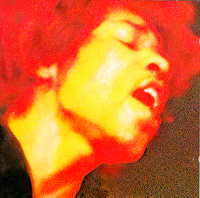 Electric Ladyland ist das ultimative Hendrix-Album und eines der wichtigsten Doppelalben dieser Zeit.
Electric Ladyland ist das ultimative Hendrix-Album und eines der wichtigsten Doppelalben dieser Zeit.

 Mehr ...
Mehr ...
|
"I'm getting myself personally together in the way of music,"
Hendrix said on the release of his third album. "Some tracks are
getting very long. That's why you can only get about twenty tracks --
our type of tracks, anyway -- onto two records." The longest track
here, "Voodoo Chile," lasts for more than fifteen minutes; with
the interplay between Steve Winwood on organ and Hendrix on guitar, it's
also one of the best. Ladyland showcases Hendrix's further explorations
of the guitar, but two of the finest tracks are the most direct: the explosive
"Crosstown Traffic" and the definitive version of Bob Dylan's
"All Along the Watchtower." (Rolling Stone)
Total album sales: 2 million - Peak chart position: 1
|
|
| John Martyn: "The Tumbler" (Island, Dez. 1968) |
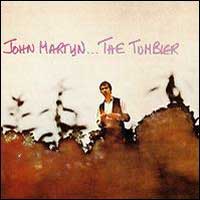 Mit knapp 18 Jahren wurde der schottische Folksänger und -gitarrist der erste
nicht-afro-amerikanische KĂ¼nstler auf Chris Blackwells Island-Label, damals
ein obskures Independent-Label fĂ¼r Reggaemusik aus Blackwells Heimat Jamaika.
Und mit "The Tumbler" liegt fĂ¼r den nunmehr 20jährigen bereits
Album #2 vor, bei dem er sich erstmals von einem zweiten Gitarristen (Paul
Wheeler), einem Bassisten (Dave Moses) und dem ebenfalls aus
Jamaika stammenden Jazzflötisten Harold
McNair begleiten lässt. Stilistisch am britischen Folk von Davey
Graham, den Pentangle Gitarristen John
Renbourn und Bert Jansch, sowie dem amerikanischen Countryblues
eines Mississippi John Hurt und Skip James orientiert, lässt
es allerdinx noch kaum erahnen, zu welchen musikalischen Höhen und zu
welcher stilistischen Vielfalt er in späteren Jahren fähig sein wĂ¼rde:
allein bei "Hello Train" ist schon ein kleiner Effekt mit rĂ¼ckwärts
laufendem Band zu hören. "Solid
Air", "Inside Out"
und "One World" sind zwar
noch nicht zu erahnen - aber trotzdem ein schönes Album. Produziert von
Al Stewart ("Year Of The Cat").
Mit knapp 18 Jahren wurde der schottische Folksänger und -gitarrist der erste
nicht-afro-amerikanische KĂ¼nstler auf Chris Blackwells Island-Label, damals
ein obskures Independent-Label fĂ¼r Reggaemusik aus Blackwells Heimat Jamaika.
Und mit "The Tumbler" liegt fĂ¼r den nunmehr 20jährigen bereits
Album #2 vor, bei dem er sich erstmals von einem zweiten Gitarristen (Paul
Wheeler), einem Bassisten (Dave Moses) und dem ebenfalls aus
Jamaika stammenden Jazzflötisten Harold
McNair begleiten lässt. Stilistisch am britischen Folk von Davey
Graham, den Pentangle Gitarristen John
Renbourn und Bert Jansch, sowie dem amerikanischen Countryblues
eines Mississippi John Hurt und Skip James orientiert, lässt
es allerdinx noch kaum erahnen, zu welchen musikalischen Höhen und zu
welcher stilistischen Vielfalt er in späteren Jahren fähig sein wĂ¼rde:
allein bei "Hello Train" ist schon ein kleiner Effekt mit rĂ¼ckwärts
laufendem Band zu hören. "Solid
Air", "Inside Out"
und "One World" sind zwar
noch nicht zu erahnen - aber trotzdem ein schönes Album. Produziert von
Al Stewart ("Year Of The Cat"). |
| The Pentangle: "Sweet Child" (Transatlantic, Dez. 1968) |
|
 Eine Platte fĂ¼r die Ewigkeit! Eine solche Mischung aus britischem Folk
und amerikanischem Jazz hat es seitdem wohl nicht mehr gegeben. Auf
diesem Doppelalbum gibt es eine Platte aus der "Royal Albert Hall"
vom 29.06.68 mit einem fĂ¼r Liveaufnahmen aus dieser Zeit fantastischem
Klang. Die zweite Platte enthält Studioaufnahmen, u.a. "I've
Got A Feeling", mein Lieblinxlied der Band , das ich schon vom
Sampler "Pentangling" kannte, den ich mir bereits damals (ca.
1973/74), also noch mit jungen Jahren, gekauft hatte. Ein schöner Akustikblues,
der auf der Miles-Davis-Nummer aufbaut, an deren Namen ich mich
im Moment aber nicht erinnern kann.
Eine Platte fĂ¼r die Ewigkeit! Eine solche Mischung aus britischem Folk
und amerikanischem Jazz hat es seitdem wohl nicht mehr gegeben. Auf
diesem Doppelalbum gibt es eine Platte aus der "Royal Albert Hall"
vom 29.06.68 mit einem fĂ¼r Liveaufnahmen aus dieser Zeit fantastischem
Klang. Die zweite Platte enthält Studioaufnahmen, u.a. "I've
Got A Feeling", mein Lieblinxlied der Band , das ich schon vom
Sampler "Pentangling" kannte, den ich mir bereits damals (ca.
1973/74), also noch mit jungen Jahren, gekauft hatte. Ein schöner Akustikblues,
der auf der Miles-Davis-Nummer aufbaut, an deren Namen ich mich
im Moment aber nicht erinnern kann.
Ein kleiner Tipp: es gibt das Doppelalbum schon seit einigen Jahren
auf einer Einzel-CD, kĂ¼rzlich (?) kam aber eine Doppel-CD raus, die
sowohl zusätzliches Live- als auch Studiomaterial beinhaltet.
Bei der Miles Davis Nummer handelt es sich natĂ¼rlich um "All Blues"
vom Meisterwerk "Kind Of Blue",
die noch weitere KĂ¼nstler inspiriert hat: u. a. Tim Buckley mit
seinem "Strange Feeling", zu finden auf dessen Meisterwerk
"Happy Sad"
(Aug. 2006)

 Mehr ...
Mehr ...
|
This album, released in 1968, at the peak of the Pentangle's career,
is probably the most representative of their work. A sprawling two-record
set, half recorded in the studio and half live at the Royal Festival Hall,
showcases just how versatile the Pentangle were in their unique brand
of English folk, jazz, Celtic, blues, and pop styles. Some of the live
covers are easily their finest performances. Furry Lewis' "Turn Your
Money Green," sung by the delightful Jacqui McShee, swings sweetly,
buttressed of course by Renbourn and Jansch's guitar tapestry. Charlie
Mingus' "Haitian Flight Song" features a great solo by bassist
Danny Thompson, who was easily one of the finest musicians to grace the
instrument. The studio tracks are uniformly excellent as well, especially
"The Time Has Come," which turns waltz time inside out. McShee,
Renbourn, and Jansch all turn in career performances on this track. But
these examples merely scratch the surface of the Pentangle's peak. The
2001 CD reissue adds four bonus tracks: alternate versions of "In
Time," "The Trees They Do Grow High," and "Hole in
the Coal," and a studio version of "Haitian Fight Song. In all,
Sweet Child is an awesome and delightful collection, and probably their
finest hour.
(by Matthew Greenwald, All
Music Guide)
|
|
| The Rolling Stones: "Beggars Banquet" (Decca, Dez. 1968) |
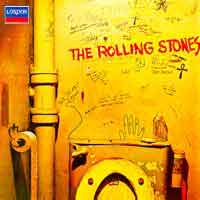 Endlich auch mal etwas von den Stones, deren ältere Studioalben fĂ¼r mich als Nachgeborenen
nie so ganz Ă¼berzeugend waren. Hier stimmt jetzt auch das Songwriting,
teilweise mit starkem Countryakzent (z.B. "No Expectations")
Endlich auch mal etwas von den Stones, deren ältere Studioalben fĂ¼r mich als Nachgeborenen
nie so ganz Ă¼berzeugend waren. Hier stimmt jetzt auch das Songwriting,
teilweise mit starkem Countryakzent (z.B. "No Expectations") |
| Duncan Browne: "Give Me Take You" (Immidiate, 1968) |
|
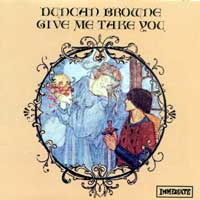 Hier
noch eine obskure WĂ¼hltischentdeckung: Duncan Browne war Engländer,
eigentlich klassischer Gitarrist, nicht mit Jackson Browne verwandt,
in den 70ern in einem blöden Synthi-Duo (sein einziger Top30-Hit, den
ich aber nicht kenne) und verstarb leider schon 1993 an einem Krebsleiden.
Dies ist sein SolodebĂ¼t als 20jähriger, produziert von Andrew Loog
Oldham (Rolling Stones) und mit sehr viel Geigen aufgepeppt und
aufgrund der guten Songs trotzdem nicht misslungen. Hier
noch eine obskure WĂ¼hltischentdeckung: Duncan Browne war Engländer,
eigentlich klassischer Gitarrist, nicht mit Jackson Browne verwandt,
in den 70ern in einem blöden Synthi-Duo (sein einziger Top30-Hit, den
ich aber nicht kenne) und verstarb leider schon 1993 an einem Krebsleiden.
Dies ist sein SolodebĂ¼t als 20jähriger, produziert von Andrew Loog
Oldham (Rolling Stones) und mit sehr viel Geigen aufgepeppt und
aufgrund der guten Songs trotzdem nicht misslungen.
"A cult collector's classic, Give Me Take You
is a beguiling period piece from 1968, a fragrant collection of delicate,
melodic, baroque-flavored songs imbued with the rose-tinted scent of
the psychedelic age." (Reissue-Liner Notes)
|
| Judy Collins: "Who Knows Where The Time Goes" (Elektra, 1968) |
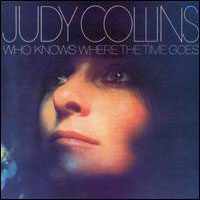 Gefunden in der Grabbelkiste!
Gefunden in der Grabbelkiste!
(18.08.2012)

 Mehr ...
Mehr ...
|
With a cast of instrumental all-stars, folk vocalist Judy Collins creates
a mini-masterwork on Who Knows Where the Times Goes. Collins' strength
as a storyteller and interpreter are at their forte throughout the disc.
Likewise, she wanders upon the precipice of less traditional folk and
more toward rock ("Hello Hooray") and even country/rock ("Poor
Immigrant") -- the latter of which, incidentally, is a cover of an
unreleased Bob Dylan composition. Additionally, her inimitable choice
of material -- Collins' sole contribution being the languid ballad "My
Father" -- serves the disc well. This is especially true of Ian Tyson's
(of Ian & Sylvia fame) "Someday Soon," which in time became
one of Collins' signature tunes. However, it is her interpretations of
Leonard Cohen's "Bird on the Wire" and the biblically based
"Story of Isaac" that are perhaps the most stunning. Both the
laid-back pedal steel guitar work of Buddy Emmons on "Bird on a Wire"
as well as the stark accompaniment of Michael Sahl's intricate harpsichord
melody on "Story of Isaac" create unique sonic imagery that
mutually distinguishes as well as defines Collins' reading from the comparatively
staid originals. However, it is "First Boy I Loved" -- originally
recorded by the Incredible String Band -- that singularly defines the
mood and timbre of Who Knows Where the Time Goes. The inherently ethereal
composition is adorned by Stephen Stills' tasty, yet restrained, fretwork
that blends seamlessly with Collins' own acoustic guitar. Together they
support -- without becoming overpowered by -- the featured rhythm section
of Jim Gordon (drums) and Chris Etheridge (bass). Enthusiasts of Judy
Collins rank this among their favorite recordings and it is likewise a
perfect touchstone for the burgeoning listener as well.
(by Lindsay Planer, All
Music Guide)
|
|
| Dion: "Dion" (Laurie, 1968) |
 Lost And Found! Lost And Found! |
| Dr. John: "Gris-Gris" (Atlantic, 1968) |
|
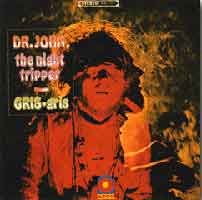 Statt
eigener Worte hier ein Zitat aus dem Klappentext der Wiederveröffentlichung: Statt
eigener Worte hier ein Zitat aus dem Klappentext der Wiederveröffentlichung:
"When Dr. John's Gris-Gris hit the rock underground
in 1968, it wasn't certain whether its master of ceremonies had
landed from outer space, or just been dredged out of hibernation from
the Louisiana swamps. The blend of druggy deep blues, incantational
background vocals, exotic mandolin and banjo trills, ritualistic percussion,
interjections of free jazz, and Dr. John's own seductive-yet-menacing
growl was like a psychedelic voodoo ceremony invading your living room.
You could be forgiven for suspecting it of having been surreptitiously
recorded in some afterhours den of black magic, the perpetuators of
this misdeed risking life-threatening curses for having exposed these
secret soundtracks to the public at large.
In fact Gris-Gris was recorded surreptitiously, but not in some New
Orleans house of sin. It was laid down in the famed Gold Star Studios
in Los Angeles, where Phil Spector had cut many of his classics. It
might have never come to pass at all had Dr. John and his co-conspirators
not managed to wrangle some free studio time that had been originally
earmarked for Sonny & Cher sessions. The resulting album nonetheless
sounded as authentically New Orleans as a midnight Mardi Gras stroll
though the French Quarter. Given the circumstances, that achievement
was just as magical as anything the most powerful voodoo ritual could
have wrought.
Gris-Gris was the first record credited to Dr. John, and to most listeners
he seemed to have dropped out of nowhere with his mystical R&B psychedelia
and Mardi Gras Indian costumes. The album, however, was actually the
culmination of about 15 years of professional experience, during which
Dr. John -- born Mac Rebennack in New Orleans -- had absorbed the wealth
of musical influences for which the Crescent City is famed. Gris-Gris's
roots reach back well beyond the dawn of the twentieth century, even
as the album took in cutting-edge influences such as 1960s progressive
jazz, and pushed into territory that no popular musician had ever explored
in quite the same fashion." (Richie Unterberger)
|
| "Earth Opera" (Elektra, 1968) |
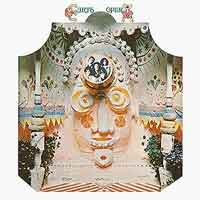 Peter Rowan und David Grisman kamen
beide aus der Bluegrass-Szene, versuchten sich hier aber zeitgemĂ¤ĂŸ an
psychedelischer Rockmusik, allerdings mit einer elektrifizierten Mandoline
als Soloinstrument, die kaum von einer E-Gitarre zu unterscheiden ist.
Peter Rowan und David Grisman kamen
beide aus der Bluegrass-Szene, versuchten sich hier aber zeitgemĂ¤ĂŸ an
psychedelischer Rockmusik, allerdings mit einer elektrifizierten Mandoline
als Soloinstrument, die kaum von einer E-Gitarre zu unterscheiden ist.

 Mehr ...
Mehr ...
Both David Grisman and singer-guitarist Peter Rowan had served serious apprenticeships with real, hardcore bluegrass bands in the 1960s. With Rowan fresh from Bill Monroe's band, and Grisman an old stalwart with the Greenbriar Boys and Red Allen's band, the two embarked on an audacious acid rock-hick twang fusion. Earth Opera was a band that was very much a product of its time, and the results were a bit murky... I have to confess, I heard these albums many, many years ago and have never gone back to revisit them. I've always had the impression that the band was actually more Rowan's baby that Grisman's, especially since the the muddled feel of these discs seems so similar to the later pop-rock efforts of the Rowan Brothers in the early '70s. Hardcore fans who are able to track these discs down may find them rewarding, but most likely these albums will merely sound like well-intentioned curiousities...
The stylistic explorations pursued by the Beatles in 1966-1967, and the commercial success the group continued to enjoy, inspired other popular musicians to be similarly ambitious and persuaded record companies to take chances on more daring music. Earth Opera is a good example. The Boston-based group's self-titled debut LP featured a heady mixture of pop, rock, folk, jazz, and classical elements in involved arrangements played on such unusual instruments as mandocello and harpsichord. Less a rock band than a highly eclectic chamber orchestra, Earth Opera played in an arty style that suited singer/songwriter/guitarist Peter Rowan's songs, with their complicated structures and highly poetic lyrics. Rowan sang those lyrics, which dealt here and there with anti-war and more generalized sentiments of social dissatisfaction, in a distanced, somewhat artificial tone of voice, using an accent that sounded vaguely British, even when he was mentioning the Red Sox. But he was rarely so specific, more often concerning himself with "the stage inside my mind" or "the picket fenceposts of your mind," internal landscapes in which wordplay and allusions substituted for specific meaning. It was a psychedelic language matched by the music, which hurried and slowed, making room for sudden solos and unexpected juxtapositions of instruments. The result ultimately may have been too ornate and inaccessible for a pop recording, even in 1968, but Earth Opera was very much of its time.
(by William Ruhlmann, All Music Guide)
|
| "Mad River" (Capitol, 1968) |
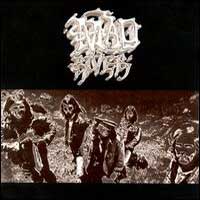 Obskure
Gitarren-Band aus der Bay Area-Szene der späten 60er, zwar nicht direkt
aus San Francisco, sondern ursprĂ¼nglich aus Ohio stammend dann ab 1967
in Berkeley ansässig. Sie ähnelten musikalisch ein bisschen Quicksilver
Messenger Service, hatten sogar drei Gitarristen an Bord und ebenfalls
nicht den besten Sänger. Trotzdem schöne Musik. Vor allem fĂ¼r 1968. Obskure
Gitarren-Band aus der Bay Area-Szene der späten 60er, zwar nicht direkt
aus San Francisco, sondern ursprĂ¼nglich aus Ohio stammend dann ab 1967
in Berkeley ansässig. Sie ähnelten musikalisch ein bisschen Quicksilver
Messenger Service, hatten sogar drei Gitarristen an Bord und ebenfalls
nicht den besten Sänger. Trotzdem schöne Musik. Vor allem fĂ¼r 1968.
(Sept. 2006) |
| Albert Mangelsdorff Quintett: "Folk Mond & Flower Dream" (L+R, 1968) |
 Lost & Found!
Lost & Found!
(04.10.2007)

 Mehr ...
Mehr ...
Im Internet werden für guterhaltene Vinyls der LP Folk Mond & Flower Dream stattliche Summen geboten. Und Jazz-Sammler fragen seit Jahrzehnten, warum es denn keine CD-Version dieser 1967 aufgenommenen Platte des Albert Mangelsdorff Quintetts gibt. Dabei ist sie ist eine der wichtigsten Platten der deutschen Jazzgeschichte. Das damals popu-lärste deutsche Jazzensemble hatte sie auf dem Höhepunkt einer Epoche aufgenommen, in der aus der Nachkriegsszenerie besonders in Frankfurt am Main eigene stilistische Entwicklungen und großartige Solisten hervorgegangen waren, die
damals auch erstmals das Interesse der Welt und besonders der Amerikaner am deutschen Jazz geweckt hat-ten. Die Öffnung zu freien Jazzformen (Free Jazz) folgte unmittelbar im Anschluss an die LP Folk Mond & Flower Dream, die das damals führende deutsche Jazzensemble auf seinem Zenit präsentiert.
Was war geschehen? Warum gab es diese LP weder als Vinyl noch als CD länger als 25 Jahre nicht auf dem Markt?
Horst Lippmann hatte das Album für sein Label L+R Records produziert, und es kam 1968 über die Firma CBS in Frankfurt in die Läden. Um 1986 hatte Horst Lippmann dann seinen L+R-Katalog mit einer großer Zahl von Jazz-, Blues- und Weltmusik-Alben an die Frankfurter Firma Bellaphon verkauft. Zu dieser Zeit eroberte die CompactDisc in rasan-tem Tempo den Markt und verdrängte die Vinyl-LP. Von den drei Albert Mangelsdorff Quintett-Klassikern erschienen als CD und Vinyl-Ersatz nur One Tension und Now Jazz Ramwong. Die andere LP Folk Mond & Flower Dream wurde
offenbar unter der Position ‚The Lost Tapes’ abgeschrieben.
Noch zu Lebzeiten hat Albert Mangelsdorff immer wieder nach dieser Platte gefragt. Unter den vielen von ihm aufgenommenen und nie als CD neu herausgekommenen Alben war ihm dies das wichtigste. Nun kommt sie an seinem 79. Geburtstag auf den Markt zurück.
|
| Thelonious Monk: "Underground" (Columbia, 1968) |
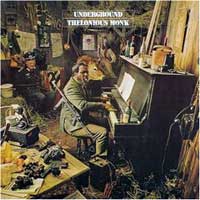 Thelonious Monk hat sich neben John Coltrane und Miles Davis
langsam aber sicher zu meinem Favoriten im Jazzbereich entwickelt. Dies
ist ein Spätwerk und ich bin (wie viele andere!) erst durch das tolle
Cover aufmerksam geworden.
Thelonious Monk hat sich neben John Coltrane und Miles Davis
langsam aber sicher zu meinem Favoriten im Jazzbereich entwickelt. Dies
ist ein Spätwerk und ich bin (wie viele andere!) erst durch das tolle
Cover aufmerksam geworden.

 Mehr ...
Mehr ...
This release has long been considered Thelonious Monk's acknowledgement to the flourishing youth-oriented subculture from whence the collection takes its name. Certainly the Grammy-winning cover art -- which depicts Monk as a World War II French revolutionary toting an automatic weapon -- gave the establishment more than the brilliant swinging sounds in the grooves to consider. Underground became Monk's penultimate studio album, as well as the final release to feature the '60s quartet: Charlie Rouse (tenor sax), Ben Riley (drums), and Larry Gales (bass) behind Monk (piano). One of the motifs running throughout Monk's recording career is the revisitation of titles from his voluminous back catalog. The tradition continues with the autobiographical leadoff track, "Thelonious." The instantly recognizable stride piano lines are delivered with the same urgency and precision that they possessed over two decades earlier when he first recorded the track for Blue Note. The presence of Charlie Rouse throughout the album is certainly worth noting. "Ugly Beauty" best captures the sacred space and musical rapport that he and Monk shared. Each musician functions as an extension of the other, creating solos that weave synchronically as if performed by the same pair of hands. Newer material, such as the playful "Green Chimneys" -- named after the school Monk's daughter attended -- as well as the unbalanced hypnotism of "Raise Four," asserts the timelessness and relevance of Monk's brand of bop. The disc ends as it begins with a new twist on an old favorite. Jon Hendricks -- who provides lyrics and vocals on "In Walked Bud" -- recalls the hustle and bustle of the real and spontaneous underground Harlem jam sessions of the late '40s. It is likewise an apt bookend to this chapter in the professional life of Thelonious Monk.
(by Thom Jurek, All Music Guide)
|
| "Os Mutantes" (Polydor, 1968) |
 Lost And Found!
Lost And Found!
(12.06.2004)

 Mehr ...
Mehr ...
| "Tropicalia upstarts Os Mutantes's 1968 debut is one
of the most playful rock records of its time--and given that it arrived
in the year of the "White Album" and We're Only in It for the
Money, that's really saying something. Screaming acid-rock guitars, quick-cut
rhythmic shifts, sound effects, jazzy vocal harmonies, and a giddy nod to
"Peppermint Twist" all have their places here. When one member
loudly slurps to punctuate a line about ice cream, it's a moment that defines
a movement's whole giddy aesthetic." (Rickey Wright) |
|
| Pearls Before Swine: "Balaklava" (ESP, 1968) |
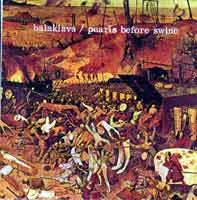 Tom Rapp und seine Band sind eine der bestgehĂ¼tetsten Geheimnisse
der Musik aus den 60ern. Dieses zweite Album gilt gemeinhin als ihr bestes.
Mitte der 70er hat sich Rapp aus dem Musikgeschäft zurĂ¼ckgezogen und wurde
Anwalt.
Tom Rapp und seine Band sind eine der bestgehĂ¼tetsten Geheimnisse
der Musik aus den 60ern. Dieses zweite Album gilt gemeinhin als ihr bestes.
Mitte der 70er hat sich Rapp aus dem Musikgeschäft zurĂ¼ckgezogen und wurde
Anwalt. |
| "Rhinoceros" (Elektra, 1968) |
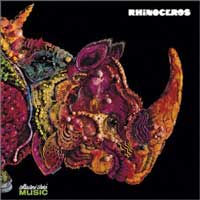 Lost And Found!
Lost And Found!
(22.10.2002)

 Mehr ...
Mehr ...
|
The product of producer Paul Rothchild, Rhinoceros was conceived, planned
and executed as a 'supergroup'. This was the groups' reason d'entre, and
ultimately, their downfall. Pieced together after a marathon series of
jams at the producers' house in the spring of 1968, the goal was to create
the heaviest band of the time. Rothchild and Elektra came very, very close.
Former members of Iron Butterfly (Danny Weiss/guitar), The Daily Flash
& Buffalo Springfield (Doug Hastings/guitar) as well as some highly
respected studio aces such as Billy Mundi on drums, they formed a very
good band indeed, but not really a group. Fortunately, although the chemistry
is a bit skewed, the music isn't half bad. There are some excellent soul-drenched
rock & soul recordings here, such as the albums' opener, "When
You Say You're Sorry" to possibly one of the best ever versions of
"You're My Girl," the group was capable of some mighty music.
One of the tracks, the heavy instrumental "Apricot Brandy" was
used as the theme for a BBC television. Ultimately, though, the group
couldn't last under the weight of the billing. However, this record is
one of the finest sounding, tightest performed albums of the period.
(by Matthew Greenwald, AMG)
|
|
| Tom Rush: "Circle Game" (Elektra, 1968) |
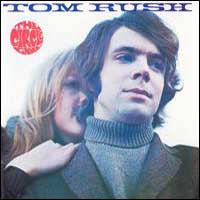 Ein von mir sehr spät entdeckter Klassiker! Auf diesem Album brilliert
Tom Rush wie immer, indem er groĂŸartige Songs anderer Songschreiber
vorstellt. Dieses mal sind es gleich drei Lieder von Joni Mitchell
(u. a. das grandiose "Urge For Going"), zwei von James
Taylor (u. a. das - ich wiederhole mich- grandiose "Something
In The Way She Moves"), je einmal Charlie Rich, Jackson
Browne und ein mir unbekannter Billy Hill, dessen "The
Glory Of Love" mir als einziges nicht so gefällt: eher Musical
oder so was mit Bläsern, während die anderen Lieder eher im Folkgenre
mit schöner Gitarrenarbeit von Rush und Gästen (u. a. Dylan-Spezi Bruce
Langhorne, Hugh McCracken und Eric Gale) bleiben.
Tom Rush, schon seit dem Beginn der 60er veröffentlichungstechnisch
dabei, war damals Katalysator fĂ¼r viele andere Songwriter, die erst
eine eigene Karriere starten konnten, nachdem er einen ihre Songs aufgenommen
hatte. Was wäre ohne Tom Rush wohl aus den Karrieren von Joni Mitchell
und Jackson Browne geworden? (Jacksons DebĂ¼talbum
kommt z.B. erst 1972 raus!) Es gibt dieses mal auch eines seiner seltenen
eigenen Lieder: das weltbekannte "No Regrets" (war mal ein
Hit fĂ¼r die Walker Brothers, wenn ich mich richtig erinnere).
Das Album ist insgesamt ein gutes Beispiel fĂ¼r die hohe Qualität der
damaligen Singer/Songwriter- und Folk-Veröffentlichungen auf Elektra!
(u.a.: The Incredible String Band, Earth
Opera, Tim Buckley,
David Ackles, David Blue und Fred
Neil)
Ein von mir sehr spät entdeckter Klassiker! Auf diesem Album brilliert
Tom Rush wie immer, indem er groĂŸartige Songs anderer Songschreiber
vorstellt. Dieses mal sind es gleich drei Lieder von Joni Mitchell
(u. a. das grandiose "Urge For Going"), zwei von James
Taylor (u. a. das - ich wiederhole mich- grandiose "Something
In The Way She Moves"), je einmal Charlie Rich, Jackson
Browne und ein mir unbekannter Billy Hill, dessen "The
Glory Of Love" mir als einziges nicht so gefällt: eher Musical
oder so was mit Bläsern, während die anderen Lieder eher im Folkgenre
mit schöner Gitarrenarbeit von Rush und Gästen (u. a. Dylan-Spezi Bruce
Langhorne, Hugh McCracken und Eric Gale) bleiben.
Tom Rush, schon seit dem Beginn der 60er veröffentlichungstechnisch
dabei, war damals Katalysator fĂ¼r viele andere Songwriter, die erst
eine eigene Karriere starten konnten, nachdem er einen ihre Songs aufgenommen
hatte. Was wäre ohne Tom Rush wohl aus den Karrieren von Joni Mitchell
und Jackson Browne geworden? (Jacksons DebĂ¼talbum
kommt z.B. erst 1972 raus!) Es gibt dieses mal auch eines seiner seltenen
eigenen Lieder: das weltbekannte "No Regrets" (war mal ein
Hit fĂ¼r die Walker Brothers, wenn ich mich richtig erinnere).
Das Album ist insgesamt ein gutes Beispiel fĂ¼r die hohe Qualität der
damaligen Singer/Songwriter- und Folk-Veröffentlichungen auf Elektra!
(u.a.: The Incredible String Band, Earth
Opera, Tim Buckley,
David Ackles, David Blue und Fred
Neil)

 Mehr ...
Mehr ...
|
"A candid and charming collection of songs that glisten as beautifully
as a clear mountain stream. Singer/songwriter/poet Tom Rush had a wonderful
idea in mind for a concept album, working with music business greats as
Arthur Gorson and Paul Harris to blend the best of the time period's songwriters.
The effort results in a splendid achievement of emotionally and lyrically
gripping material. Taking advantage of his resonant tenor voice and the
majestic talents of a stirring crew of musicians, Rush performs wistful
and ethereal versions of some of his favorite songs. Material selected
include deeply lyrical tunes such as Joni Mitchell's "Tin Angel"
and "Urge for Going," and the romantic works of James Taylor's
"Something in the Way She Moves." The album, entitled The Circle
Game, featured Mitchell's radio hit single of the same name. Certainly
during the '70s this album was marketed well and fared with great success
among the listening public, inviting Rush into an elite group of solo
singer/songwriters of the decade. Just to prove to the world that he is
no fluke himself when it comes to arranging and composing, Rush succeeds
with two beautifully crafted works of his own, masterfully woven and spun
on the acoustic guitar. An endearing work of lush production featuring
the brilliant efforts of conductor Paul Harris and orchestra. A must-listen
for listeners sincerely curious and seeking a good singer/songwriter talent
during this period."
(Shawn M. Haney, All
Music Guide)
|
|
| Dusty Springfield: "Dusty In Memphis" (Philips, 1968) |
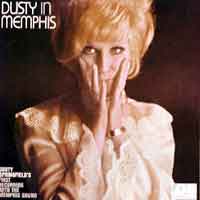 Dusty Springfield, britische Balladensängerin, trifft auf die "Memphis-Musik-Mafia",
die schon Aretha Franklin, Wilson Pickett und anderen
Soulsänger/innen zu Glanz verholfen hat. Das hätte schief gehen können,
wurde aber zu einer Sternstunde der Popmusik. U. a. m.: "Son Of
A Preacherman", "Breakfast in Bed" (Donnie
Fritts) und mehreren Titeln von Randy Newman und Goffin/King
("No Easy Way Down", "I Can't Make It Alone").
Dusty Springfield, britische Balladensängerin, trifft auf die "Memphis-Musik-Mafia",
die schon Aretha Franklin, Wilson Pickett und anderen
Soulsänger/innen zu Glanz verholfen hat. Das hätte schief gehen können,
wurde aber zu einer Sternstunde der Popmusik. U. a. m.: "Son Of
A Preacherman", "Breakfast in Bed" (Donnie
Fritts) und mehreren Titeln von Randy Newman und Goffin/King
("No Easy Way Down", "I Can't Make It Alone").

 Mehr ...
Mehr ...
| "Dusty In Memphis is living proof that great, soulful
pop art can be sculpted and groomed, can be birthed by backroom boys in
A&R departments yet sacrifice none of its integrity. Ahmet Ertegun,
head of the Atlantic label, was the one who made it happen. He was bewitched
by how Dusty could subtly twist and shape each phrase according to the contours
of her soul. In the 1960s, she tried many styles, from wall-of-sound bombast
through Burt Bacharach and Motown but nobody had set her up with a tight
R&B group. So Ertegun brought her to Memphis and teamed her with the
Memphis Cats, a rhythm section famed for work with titans such as Wilson
Pickett and Elvis. Despite the master plan, Dusty In Memphis surprised everyone
involved, outstripping its initial Dusty-does-R&B remit and going on
to stand as her greatest, most coherent work. The Memphis Cats subtly toughened
up Dusty's sound without making it too muscular, opening up lots of space
for her to stretch her vocals. Son Of A Preacher Man was the album's most
successful offspring but every track sparkles with a radiant beauty."
|
|
| "Caetano Veloso" (Philips, 1968) |
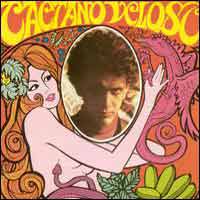 Brazil!
Brazil!
(30.07.2018)

 Mehr ...
Mehr ...
|
by Alvaro Neder
The first Caetano Veloso solo album was recorded in 1967. Soon after
the III FMPB, where Veloso took fourth place with "Alegria, Alegria,"
he and his group (which would soon constitute the tropicália movement)
were news, dividing opinions concerning the group's interest in fusing
Brazilian music with international pop culture, lysergic psychedelia,
generalized irreverence, and whatever crossed their minds. The arrangements
were done by three classically trained composers, fully committed to the
most adventurous experiments in modern music: Júlio Medaglia, Damiano
Cozzella, and Sandino Hohagen. Veloso's concept was that the album should
surpass the Beatles' Sgt. Pepper's, being also very Brazilian and, at
the same time, international. The record has immortal classics, such as
"Clarice," "Soy Loco Por Ti América" (Gilberto
Gil/Capinam), composed under the effect of the recent death of Che Guevara,
"Superbacana," "Tropicália," and "Alegria,
Alegria." The rest of the album has had less success but consists
of excellent tracks that remain modern until today. "Tropicália,"
the title track, was an unnamed song when its recording began. By suggestion
of the then photographer Luís Carlos Barreto, Veloso used the same
name of an installation by the visual artist Hélio Oiticica, which
was composed by a labyrinth made with plants and birds conducing to a
television set. The suggestion was accepted -- and the tropicália
was born.
|
|
| "TropicĂ¡lia - Ou Panis Et Circensis" (Philips, 1968) |
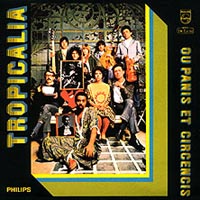 Die Album gilt als der Beginn des brasilianischen Musikstils "Tropicalia",
der brasilianische (Bossa Nova, Samba) und anglo-amerikanische Popmusik
zusammenbrachte. Alles war erlaubt. Entsprechend bunt diese Mischung,
angerĂ¼hrt von Caetano Veloso, Gilberto Gil, Gal Costa, Os
Mutantes und anderen.
Die Album gilt als der Beginn des brasilianischen Musikstils "Tropicalia",
der brasilianische (Bossa Nova, Samba) und anglo-amerikanische Popmusik
zusammenbrachte. Alles war erlaubt. Entsprechend bunt diese Mischung,
angerĂ¼hrt von Caetano Veloso, Gilberto Gil, Gal Costa, Os
Mutantes und anderen.
(04.02.2009)

 Mehr ...
Mehr ...
This is the compilation that helped to define the sound of Tropicalia, a Brazilian label whose artists made huge and influential strides in creating exotic pop that was as influenced by psychedelia as it was by samba, bossa nova, and more traditional South American genres. Tropicália not only includes tracks from the label's most important acts (Gilberto Gil, Os Mutantes, Caetano Veloso, Gal Costa), but presents a large number of collaborations between these artists, many of which are simply amazing. Given the fact that many of the original Tropicalia releases have not been reissued or are not widely available, the compilation stands as a near-definitive package for the sound, and a great opportunity for anyone unfamiliar with the artists to experience an amazing and hugely important genre.
(by Nitsuh Abebe, All Music Guide)
Ursprünglich 1969 veröffentlicht, ist dieses Album eines der wichtigsten in der musikalischen sowie politischen Geschichte Brasiliens. Durch ihren im musikalischen Gewand verpackten politischen Protest gegen das damalige, brasilianische Regime fanden sich Gilberto Gil und Caetano veloso erst im Gefängnis und später im britischen Exil wieder.
|
 Das Album des Jahres
Das Album des Jahres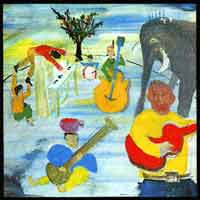 Das DebĂ¼t von Dylans ehemaliger Begleitband unter eigenem Namen. Ein toller
Songschreiber (Robbie Robertson), drei tolle Sänger (Levon Helm,
Rick Danko und Richard Manuel) und ein genialer Instrumentalist
(Garth Hudson). Diese "Urplatte des Americana-Sounds"
klang schon 1968 so, als wäre sie uralt. Mit vielen Klassikern: "Tears
Of Rage", "The
Weight", "Chest Fever", "This Wheel's On Fire"
und Dylans "I Shall Be Released".
Das DebĂ¼t von Dylans ehemaliger Begleitband unter eigenem Namen. Ein toller
Songschreiber (Robbie Robertson), drei tolle Sänger (Levon Helm,
Rick Danko und Richard Manuel) und ein genialer Instrumentalist
(Garth Hudson). Diese "Urplatte des Americana-Sounds"
klang schon 1968 so, als wäre sie uralt. Mit vielen Klassikern: "Tears
Of Rage", "The
Weight", "Chest Fever", "This Wheel's On Fire"
und Dylans "I Shall Be Released".
 Mehr ...
Mehr ...
 weitere Highlights ...
weitere Highlights ...  Mahals DebĂ¼talbum. In seiner Band hatte er damals gleich zwei herausragende Gitarristen: Jesse Ed Davis und Ry Cooder.
Mahals DebĂ¼talbum. In seiner Band hatte er damals gleich zwei herausragende Gitarristen: Jesse Ed Davis und Ry Cooder.
 Cohen
war vor diesem musikalischen DebĂ¼t schon als Dichter in Erscheinung getreten
und auch bereits in seinen DreiĂŸigern. Die Platte war sehr erfolgreich
und enthält einige seiner grĂ¶ĂŸten Hits: "Suzanne", "Sisters
Of Mercy" und "So Long Marianne".
Cohen
war vor diesem musikalischen DebĂ¼t schon als Dichter in Erscheinung getreten
und auch bereits in seinen DreiĂŸigern. Die Platte war sehr erfolgreich
und enthält einige seiner grĂ¶ĂŸten Hits: "Suzanne", "Sisters
Of Mercy" und "So Long Marianne". Definitiv eines meines Lieblinxalben aus den 60ern!
Definitiv eines meines Lieblinxalben aus den 60ern!
 Posthum hatte Otis mit dem Titelsong seinen grĂ¶ĂŸten Hit!
Posthum hatte Otis mit dem Titelsong seinen grĂ¶ĂŸten Hit!
 Eine der besten Jazzplatten aus dieser Zeit und eine der letzten Davis-Platten
mit dem alten Quintett - Herbie Hancock (p), Wayne Shorter
(sax), Ron Carter (bass) und Tony Williams (dr) - im alten
akustischen Sound.
Eine der besten Jazzplatten aus dieser Zeit und eine der letzten Davis-Platten
mit dem alten Quintett - Herbie Hancock (p), Wayne Shorter
(sax), Ron Carter (bass) und Tony Williams (dr) - im alten
akustischen Sound.
 Mehr ...
Mehr ...
 In den Jahren 1967-69 war die schottischen Multiinstrumentalisten Mike Heron
und Robin Williamson mit ihrer originellen Mischung
aus Folk- und Weltmusik sehr erfolgreich und brachten es in dieser Zeit
zu 5 Alben. Das lief meistens so ab: abwechselnd sang einer sein Lied
und begleitete sich vornehmlich auf der Gitarre, während der andere jeweils
fĂ¼r Arrangement und zusätzliche Instrumente zuständig war. Gegenseitig
stachelten sich sich dabei zu Höchstleistungen an. Manchmal lieĂŸen sich
sich auch von ihren Freundinnen begleiten (und ablenken?) oder hatten
einmal sogar eine Balletttruppe dabei. Heutzutage hätte wohl kaum eine
groĂŸe Plattenfirma soviel Gottvertrauen in ihre Musiker wie Elektra damals!
Produziert hatte der in London ansässige Amerikaner Joe Boyd (erste
Pink Floyd-Single "See Emily Play", Fairport
Convention, etc.)
In den Jahren 1967-69 war die schottischen Multiinstrumentalisten Mike Heron
und Robin Williamson mit ihrer originellen Mischung
aus Folk- und Weltmusik sehr erfolgreich und brachten es in dieser Zeit
zu 5 Alben. Das lief meistens so ab: abwechselnd sang einer sein Lied
und begleitete sich vornehmlich auf der Gitarre, während der andere jeweils
fĂ¼r Arrangement und zusätzliche Instrumente zuständig war. Gegenseitig
stachelten sich sich dabei zu Höchstleistungen an. Manchmal lieĂŸen sich
sich auch von ihren Freundinnen begleiten (und ablenken?) oder hatten
einmal sogar eine Balletttruppe dabei. Heutzutage hätte wohl kaum eine
groĂŸe Plattenfirma soviel Gottvertrauen in ihre Musiker wie Elektra damals!
Produziert hatte der in London ansässige Amerikaner Joe Boyd (erste
Pink Floyd-Single "See Emily Play", Fairport
Convention, etc.)
 Mehr ...
Mehr ...
 Mit gerade mal 21 Jahren war Laura Nyro schon eine der wichtigsten Sängerinnen,
Pianistinnen und Songschreiberinnen ihrer Generation! Sie verband Jazz,
Soul, Pop und Musical zu einer einzigartigen Mischung. Dies ist ihr zweites
Album und ihr DebĂ¼t bei Columbia und enthält einige ihrer grĂ¶ĂŸten Songs,
die allerdings nur in Versionen anderer KĂ¼nstler bekannt wurden: The
Fifth Dimension nahmen "Sweet Blindness" und "Stoned
Soul Picnic" auf, Three Dog Night den Titelsong "Eli's
Coming". Ohne Laura Nyro's Pionierarbeit sind solche KĂ¼nstlerinnen
wie Ricky Lee Jones, Suzanne Vega, Tori Amos und
auch Ani DiFranco kaum vorstellbar!
Mit gerade mal 21 Jahren war Laura Nyro schon eine der wichtigsten Sängerinnen,
Pianistinnen und Songschreiberinnen ihrer Generation! Sie verband Jazz,
Soul, Pop und Musical zu einer einzigartigen Mischung. Dies ist ihr zweites
Album und ihr DebĂ¼t bei Columbia und enthält einige ihrer grĂ¶ĂŸten Songs,
die allerdings nur in Versionen anderer KĂ¼nstler bekannt wurden: The
Fifth Dimension nahmen "Sweet Blindness" und "Stoned
Soul Picnic" auf, Three Dog Night den Titelsong "Eli's
Coming". Ohne Laura Nyro's Pionierarbeit sind solche KĂ¼nstlerinnen
wie Ricky Lee Jones, Suzanne Vega, Tori Amos und
auch Ani DiFranco kaum vorstellbar! Pentangles DebĂ¼talbum habe ich erst relativ spät entdeckt (natĂ¼rlich in
der CD-Grabbelkiste), aber es hat schon alles, was die späteren Alben
so groĂŸartig macht. Das liegt sicherlich auch daran, dass alle Beteiligten
keine Newcomer, sondern bereits etablierte und ausgereifte Musiker waren.
Pentangles DebĂ¼talbum habe ich erst relativ spät entdeckt (natĂ¼rlich in
der CD-Grabbelkiste), aber es hat schon alles, was die späteren Alben
so groĂŸartig macht. Das liegt sicherlich auch daran, dass alle Beteiligten
keine Newcomer, sondern bereits etablierte und ausgereifte Musiker waren.
 Mehr ...
Mehr ...

 Mehr ...
Mehr ...
 Steve Miller und Boz Scaggs lieferten zusammen mit dem Produzenten
Glyn Johns eines der ersten "Psychedelic Rock"-Alben
ab. U. a. m. Boz Scaggs Klassiker "Baby's Calling Me Home".
Steve Miller und Boz Scaggs lieferten zusammen mit dem Produzenten
Glyn Johns eines der ersten "Psychedelic Rock"-Alben
ab. U. a. m. Boz Scaggs Klassiker "Baby's Calling Me Home".
 Mehr ...
Mehr ...
 Als
1968 die CBS ODESSEY & ORACLE veröffentlichte, erregte die Platte
erstmal kein Aufsehen. In den USA wurde sogar von einer Veröffentlichung
ganz abgesehen ... bis Al Kooper (damals bei Blood, Sweat &
Tears), begeistert von dem melodiösen Sound dieses Albums, CBS drängte
die LP unbedingt raus zubringen. (Er selbst schrieb fĂ¼r das Plattencover
dann die Liner Notes.) Als dann schlieĂŸlich noch "Time Of The Season",
gesungen vom phantastischen Sänger Colin Blunstone und komponiert
vom Keyboarder Rod Argent, als Single herauskam und Chart-Position
3 in den USA erreichte, erkannte auch die Ă–ffentlichkeit den wahren Geist
dieses Meisterwerkes, welches in seiner harmonischen klangvollen Kraft
und seiner akustischen Präsenz höchstens nur noch von Pet
Sounds getoppt wurde.
Als
1968 die CBS ODESSEY & ORACLE veröffentlichte, erregte die Platte
erstmal kein Aufsehen. In den USA wurde sogar von einer Veröffentlichung
ganz abgesehen ... bis Al Kooper (damals bei Blood, Sweat &
Tears), begeistert von dem melodiösen Sound dieses Albums, CBS drängte
die LP unbedingt raus zubringen. (Er selbst schrieb fĂ¼r das Plattencover
dann die Liner Notes.) Als dann schlieĂŸlich noch "Time Of The Season",
gesungen vom phantastischen Sänger Colin Blunstone und komponiert
vom Keyboarder Rod Argent, als Single herauskam und Chart-Position
3 in den USA erreichte, erkannte auch die Ă–ffentlichkeit den wahren Geist
dieses Meisterwerkes, welches in seiner harmonischen klangvollen Kraft
und seiner akustischen Präsenz höchstens nur noch von Pet
Sounds getoppt wurde.  Cash's kommerzieller Durchbruch war dieser Konzertmitschnitt aus dem Knast.
Cash's kommerzieller Durchbruch war dieser Konzertmitschnitt aus dem Knast.
 Das
DebĂ¼t der einer Klasseband, die in San Francisco neben den Grateful
Dead und Jefferson Airplane damals leider etwas untergegangen
sind. Zwar nicht so gut wie ihr Meisterwerk "Happy
Trails", aber besser als viele ihrer Versuche in den 70ern. Mit
dem genialen John Cipollina an der Gitarre!
Das
DebĂ¼t der einer Klasseband, die in San Francisco neben den Grateful
Dead und Jefferson Airplane damals leider etwas untergegangen
sind. Zwar nicht so gut wie ihr Meisterwerk "Happy
Trails", aber besser als viele ihrer Versuche in den 70ern. Mit
dem genialen John Cipollina an der Gitarre!
 Mehr ...
Mehr ...
 Lost And Found!
Lost And Found! Roger
Chapman gab's auch schon in den 60ern! Lange vor den Shorlists,
lange vor den Streetwalkers.
Mit dabei als Gitarrist und Songwriting-Partner Charlie Whitney,
mit dem er nach dem Ende der Family als Chapman/Whitney-Streetwalkers
weitermachte. Bassisten wurden in der Familie so einige verschlissen,
auf diesem Album, ihrem besten so weit ich das beurteilen kann, ist es
Ric Grech, der danach als einziger "Unbekannter" in der
kurzlebigen "Allstartruppe" Blind Faith (neben Eric
Clapton, Ginger Baker und Steve Winwood) landete. Die
Musik der Family? NatĂ¼rlich wegen der Stimme schon "typisch Chappo",
aber von der Musik her noch nicht so konventionell wie später bei den
Shortlists. Irgendwie war damals ja
"Progressive Rock" schwer angesagt und Family war vorne mit
dabei.
Roger
Chapman gab's auch schon in den 60ern! Lange vor den Shorlists,
lange vor den Streetwalkers.
Mit dabei als Gitarrist und Songwriting-Partner Charlie Whitney,
mit dem er nach dem Ende der Family als Chapman/Whitney-Streetwalkers
weitermachte. Bassisten wurden in der Familie so einige verschlissen,
auf diesem Album, ihrem besten so weit ich das beurteilen kann, ist es
Ric Grech, der danach als einziger "Unbekannter" in der
kurzlebigen "Allstartruppe" Blind Faith (neben Eric
Clapton, Ginger Baker und Steve Winwood) landete. Die
Musik der Family? NatĂ¼rlich wegen der Stimme schon "typisch Chappo",
aber von der Musik her noch nicht so konventionell wie später bei den
Shortlists. Irgendwie war damals ja
"Progressive Rock" schwer angesagt und Family war vorne mit
dabei. Mit UnterstĂ¼tzung der drei Velvets Lou Reed, John Cale und
Sterling Morrison sowie Jackson
Browne entstand diese wunderbare erste Soloplatte von Christa Päffgen
aus Köln, genannt Nico. Sie nahm drei Lieder von Jackson Browne (u.a.
die erste Version von "These Days") und fĂ¼nf der Velvet-Musiker
(vor allem der Titelsong und das 8minĂ¼tige "It Was A Pleasure Then"
sind bemerkenswert) auf. Dazu kamen Dylans "I'll Keep
It With Mine" und Tim Hardins "Eulogy To Lenny Bruce".
Nicos "Nicht-Gesang" ist beeindruckend, ebenso das Spiel der
drei Velvets. Auch der damals 19jährige Jackson Browne macht keine schlechte
Figur.
Mit UnterstĂ¼tzung der drei Velvets Lou Reed, John Cale und
Sterling Morrison sowie Jackson
Browne entstand diese wunderbare erste Soloplatte von Christa Päffgen
aus Köln, genannt Nico. Sie nahm drei Lieder von Jackson Browne (u.a.
die erste Version von "These Days") und fĂ¼nf der Velvet-Musiker
(vor allem der Titelsong und das 8minĂ¼tige "It Was A Pleasure Then"
sind bemerkenswert) auf. Dazu kamen Dylans "I'll Keep
It With Mine" und Tim Hardins "Eulogy To Lenny Bruce".
Nicos "Nicht-Gesang" ist beeindruckend, ebenso das Spiel der
drei Velvets. Auch der damals 19jährige Jackson Browne macht keine schlechte
Figur.
 Mehr ...
Mehr ...
 Auf diesem Album konvertierten die Byrds zur Countrymusik, was sicherlich
auf Gram Parsons Einfluss zurĂ¼ckzufĂ¼hren ist, der allerdings
nach dieser Platte die Band bereits wieder verlieĂŸ und mit Chris
Hillman die Flying Burrito
Brothers grĂ¼ndete. Zu den Highlights gehören Parsons "Hickory
Wind", Dylans "You Ain't Goin' Nowhere" und der
Soulklassiker "You Don't Miss Your Water". Grams Leadvocals
sind leider alle aus "kommerziellen GrĂ¼nden" mit Roger McGuinns
Gesängen ausgetauscht worden. Die Ursprungsversionen kann man auf diversen
Samplern nachhören.
Auf diesem Album konvertierten die Byrds zur Countrymusik, was sicherlich
auf Gram Parsons Einfluss zurĂ¼ckzufĂ¼hren ist, der allerdings
nach dieser Platte die Band bereits wieder verlieĂŸ und mit Chris
Hillman die Flying Burrito
Brothers grĂ¼ndete. Zu den Highlights gehören Parsons "Hickory
Wind", Dylans "You Ain't Goin' Nowhere" und der
Soulklassiker "You Don't Miss Your Water". Grams Leadvocals
sind leider alle aus "kommerziellen GrĂ¼nden" mit Roger McGuinns
Gesängen ausgetauscht worden. Die Ursprungsversionen kann man auf diversen
Samplern nachhören.
 Mehr ...
Mehr ...
 Auf
diesem Album haben die Dead versucht, ihre Stärke als Live-Jam-Band in
eine Studioproduktion einzubringen. Dazu wurden Livebänder mit Studioaufnahmen
gemischt. Der von Warner angeheuerte teure Produzent David Hassinger
(er hat -glaub ich- auch mit den Stones aufgenommen) muss dabei fast verzweifelt
sein (diese unprofessionellen Hippies!). Hier ein Tipp: es gibt aus der
Videoreihe "Classic Rock Albums" (oder so ähnlich) eine Folge
der Dead mit dem Namen "From Anthem To Beauty", die sich mit
der Entstehung der Alben "Anthem Of The Sun" und "American
Beauty" beschäftigt. Total spannend zu verfolgen. Ansonsten gefallen
mir die reinen Livealben (z.B. "Live/Dead"
oder "Europe 72") und
die späteren songorientierten Studioalben ("Workingman's
Dead" und "American
Beauty") besser als das FrĂ¼hwerk. Von den zum Teil kryptischen
Songs hat sich nur die Weir/Kreutzmann-Komposition "The Other One"
einen wichtigen Platz im Live-Repertoire der Band erobert. Ach ja- erstmalig
treten Robert Hunter als Texter und Mickey Hart als zweiter
Trommler in Erscheinung.
Auf
diesem Album haben die Dead versucht, ihre Stärke als Live-Jam-Band in
eine Studioproduktion einzubringen. Dazu wurden Livebänder mit Studioaufnahmen
gemischt. Der von Warner angeheuerte teure Produzent David Hassinger
(er hat -glaub ich- auch mit den Stones aufgenommen) muss dabei fast verzweifelt
sein (diese unprofessionellen Hippies!). Hier ein Tipp: es gibt aus der
Videoreihe "Classic Rock Albums" (oder so ähnlich) eine Folge
der Dead mit dem Namen "From Anthem To Beauty", die sich mit
der Entstehung der Alben "Anthem Of The Sun" und "American
Beauty" beschäftigt. Total spannend zu verfolgen. Ansonsten gefallen
mir die reinen Livealben (z.B. "Live/Dead"
oder "Europe 72") und
die späteren songorientierten Studioalben ("Workingman's
Dead" und "American
Beauty") besser als das FrĂ¼hwerk. Von den zum Teil kryptischen
Songs hat sich nur die Weir/Kreutzmann-Komposition "The Other One"
einen wichtigen Platz im Live-Repertoire der Band erobert. Ach ja- erstmalig
treten Robert Hunter als Texter und Mickey Hart als zweiter
Trommler in Erscheinung. Zwar
ohne Hits, aber mit "Triad", David Crosbys Song Ă¼ber eine Dreiecksgeschichte,
den Roger McGuinn bei den Byrds gerĂ¼chteweise nicht spielen wollte. Dass
Crosby danach die Byrds verlieĂŸ und mit seinen neuen Partnern Stills,
Nash und Young das Lied sehr erfolgreich spielen konnte, ist eine andere
Geschichte. Hier wird die Nummer aber von einer Frau (Grace Slick) gesungen,
was das ganze fĂ¼r viele puritanische Zeitgenossen sogar noch provokanter
machte.
Zwar
ohne Hits, aber mit "Triad", David Crosbys Song Ă¼ber eine Dreiecksgeschichte,
den Roger McGuinn bei den Byrds gerĂ¼chteweise nicht spielen wollte. Dass
Crosby danach die Byrds verlieĂŸ und mit seinen neuen Partnern Stills,
Nash und Young das Lied sehr erfolgreich spielen konnte, ist eine andere
Geschichte. Hier wird die Nummer aber von einer Frau (Grace Slick) gesungen,
was das ganze fĂ¼r viele puritanische Zeitgenossen sogar noch provokanter
machte. Ein eher unbekannter Singer/Songwriter aus den Spät60ern, den man - wenn
Ă¼berhaupt - nur als Komponist des Julie Driscoll/Brian Auger-Hits
"Road To Cairo" kennt, der sich auf diesem
Album befindet und auch fĂ¼r mich der Grund war, vor einiger Zeit die CD
zu kaufen. Wie klingt das Ganze nun? Man könnte sagen: "typisch Elektra
ca. 66-69"! Das Label, welches auch heutzutage als Unterabteilung
von AOL/Time/Warner noch immer existiert und mit Bands wie Metallica
Geld scheffelt, war damals eher ein Folk/Singer/Songwriter-Label und ziemlich
hip: dabei waren, mit durchaus vergleichbarer Musik u. a.: Tim
Buckley, Fred Neil, Mickey Newbury,
Tom Rush und David Blue. Und Rockband wie die Doors
(noch) die Ausnahme.
Ein eher unbekannter Singer/Songwriter aus den Spät60ern, den man - wenn
Ă¼berhaupt - nur als Komponist des Julie Driscoll/Brian Auger-Hits
"Road To Cairo" kennt, der sich auf diesem
Album befindet und auch fĂ¼r mich der Grund war, vor einiger Zeit die CD
zu kaufen. Wie klingt das Ganze nun? Man könnte sagen: "typisch Elektra
ca. 66-69"! Das Label, welches auch heutzutage als Unterabteilung
von AOL/Time/Warner noch immer existiert und mit Bands wie Metallica
Geld scheffelt, war damals eher ein Folk/Singer/Songwriter-Label und ziemlich
hip: dabei waren, mit durchaus vergleichbarer Musik u. a.: Tim
Buckley, Fred Neil, Mickey Newbury,
Tom Rush und David Blue. Und Rockband wie die Doors
(noch) die Ausnahme.
 Mehr ...
Mehr ...
 Mehr ...
Mehr ...

 Mehr ...
Mehr ...
 Bei
den Byrds war Gene Clark fĂ¼r die besten Songs verantwortlich
("Eight Miles High", "Feel A Whole Lot Better"),
durfte im Schatten von Roger McGuinn aber meist nur Chorstimme singen
und das Tamburine schwingen. Auf dieser Platte tat er sich mit dem
Banjospieler Doug Dillard zusammen. Mit dabei war auch der spätere
"Burrito-Brother" und "Eagle"
Bernie Leadon.
Bei
den Byrds war Gene Clark fĂ¼r die besten Songs verantwortlich
("Eight Miles High", "Feel A Whole Lot Better"),
durfte im Schatten von Roger McGuinn aber meist nur Chorstimme singen
und das Tamburine schwingen. Auf dieser Platte tat er sich mit dem
Banjospieler Doug Dillard zusammen. Mit dabei war auch der spätere
"Burrito-Brother" und "Eagle"
Bernie Leadon. Im Oktober 1968 veröffentlichte unser Duo sogar zwei Alben gleichzeitig,
die es dann teilweise auch als Doppelalbum zusammen zu kaufen gab. Sehr
verwirrend.
Im Oktober 1968 veröffentlichte unser Duo sogar zwei Alben gleichzeitig,
die es dann teilweise auch als Doppelalbum zusammen zu kaufen gab. Sehr
verwirrend.
 Mehr ...
Mehr ...
 Mehr ...
Mehr ...
 Mit dem zweiten Album innerhalb eines Jahres gibt es eine weitere Steigerung.
Man kann sogar sagen, dass die Band bereits vor Pink Floyd "Pink
Floyd-Musik" gespielt hat. AuĂŸerdem werden die eigenen Blueswurzeln
gepflegt (Jimmy Reeds "You're So Fine"), Pophits gemacht
("Living In The U.S.A.") und Johnny "Guitar" Watsons
"Gangster Of Love" der Welt näher gebracht. Bestes Lied aber
ist die Hippie-Ballade "Dear Mary".
Mit dem zweiten Album innerhalb eines Jahres gibt es eine weitere Steigerung.
Man kann sogar sagen, dass die Band bereits vor Pink Floyd "Pink
Floyd-Musik" gespielt hat. AuĂŸerdem werden die eigenen Blueswurzeln
gepflegt (Jimmy Reeds "You're So Fine"), Pophits gemacht
("Living In The U.S.A.") und Johnny "Guitar" Watsons
"Gangster Of Love" der Welt näher gebracht. Bestes Lied aber
ist die Hippie-Ballade "Dear Mary".
 Mehr ...
Mehr ...
 Was soll man sagen? Das letzte Meisterwerk der Beatles, besser als die
danach noch folgenden "Let It Be" und "Abbey Road",
obwohl auch die ihre Momente haben.
Was soll man sagen? Das letzte Meisterwerk der Beatles, besser als die
danach noch folgenden "Let It Be" und "Abbey Road",
obwohl auch die ihre Momente haben.
 Mehr ...
Mehr ...
 Nach der Zeit mit Them und nicht ganz glĂ¼cklichen Versuchen als
Solist (später als "T.B. Sheets" und unter anderen Namen immer
wieder mehr oder weniger seriös veröffentlicht) gelang ihm mit dieser
Platte der kĂ¼nstlerische Durchbruch. Folk, Blues und Jazz verbinden
sich zu einer neuen Ă„sthetik. Neben dem Titelsong sind besonders "Madame
George" und "Sweet Thing" hervorzuheben. In der Band
sind besonders die Jazzmusiker Jay Berliner (Gitarre), Richard
Davis (Kontrabass) und Connie Kay (Schlagzeug) zu erwähnen.
Nach der Zeit mit Them und nicht ganz glĂ¼cklichen Versuchen als
Solist (später als "T.B. Sheets" und unter anderen Namen immer
wieder mehr oder weniger seriös veröffentlicht) gelang ihm mit dieser
Platte der kĂ¼nstlerische Durchbruch. Folk, Blues und Jazz verbinden
sich zu einer neuen Ă„sthetik. Neben dem Titelsong sind besonders "Madame
George" und "Sweet Thing" hervorzuheben. In der Band
sind besonders die Jazzmusiker Jay Berliner (Gitarre), Richard
Davis (Kontrabass) und Connie Kay (Schlagzeug) zu erwähnen.
 Mehr ...
Mehr ...
 Electric Ladyland ist das ultimative Hendrix-Album und eines der wichtigsten Doppelalben dieser Zeit.
Electric Ladyland ist das ultimative Hendrix-Album und eines der wichtigsten Doppelalben dieser Zeit.
 Mehr ...
Mehr ...
 Mit knapp 18 Jahren wurde der schottische Folksänger und -gitarrist der erste
nicht-afro-amerikanische KĂ¼nstler auf Chris Blackwells Island-Label, damals
ein obskures Independent-Label fĂ¼r Reggaemusik aus Blackwells Heimat Jamaika.
Und mit "The Tumbler" liegt fĂ¼r den nunmehr 20jährigen bereits
Album #2 vor, bei dem er sich erstmals von einem zweiten Gitarristen (Paul
Wheeler), einem Bassisten (Dave Moses) und dem ebenfalls aus
Jamaika stammenden Jazzflötisten Harold
McNair begleiten lässt. Stilistisch am britischen Folk von Davey
Graham, den Pentangle Gitarristen John
Renbourn und Bert Jansch, sowie dem amerikanischen Countryblues
eines Mississippi John Hurt und Skip James orientiert, lässt
es allerdinx noch kaum erahnen, zu welchen musikalischen Höhen und zu
welcher stilistischen Vielfalt er in späteren Jahren fähig sein wĂ¼rde:
allein bei "Hello Train" ist schon ein kleiner Effekt mit rĂ¼ckwärts
laufendem Band zu hören. "Solid
Air", "Inside Out"
und "One World" sind zwar
noch nicht zu erahnen - aber trotzdem ein schönes Album. Produziert von
Al Stewart ("Year Of The Cat").
Mit knapp 18 Jahren wurde der schottische Folksänger und -gitarrist der erste
nicht-afro-amerikanische KĂ¼nstler auf Chris Blackwells Island-Label, damals
ein obskures Independent-Label fĂ¼r Reggaemusik aus Blackwells Heimat Jamaika.
Und mit "The Tumbler" liegt fĂ¼r den nunmehr 20jährigen bereits
Album #2 vor, bei dem er sich erstmals von einem zweiten Gitarristen (Paul
Wheeler), einem Bassisten (Dave Moses) und dem ebenfalls aus
Jamaika stammenden Jazzflötisten Harold
McNair begleiten lässt. Stilistisch am britischen Folk von Davey
Graham, den Pentangle Gitarristen John
Renbourn und Bert Jansch, sowie dem amerikanischen Countryblues
eines Mississippi John Hurt und Skip James orientiert, lässt
es allerdinx noch kaum erahnen, zu welchen musikalischen Höhen und zu
welcher stilistischen Vielfalt er in späteren Jahren fähig sein wĂ¼rde:
allein bei "Hello Train" ist schon ein kleiner Effekt mit rĂ¼ckwärts
laufendem Band zu hören. "Solid
Air", "Inside Out"
und "One World" sind zwar
noch nicht zu erahnen - aber trotzdem ein schönes Album. Produziert von
Al Stewart ("Year Of The Cat"). Mehr ...
Mehr ...
 Endlich auch mal etwas von den Stones, deren ältere Studioalben fĂ¼r mich als Nachgeborenen
nie so ganz Ă¼berzeugend waren. Hier stimmt jetzt auch das Songwriting,
teilweise mit starkem Countryakzent (z.B. "No Expectations")
Endlich auch mal etwas von den Stones, deren ältere Studioalben fĂ¼r mich als Nachgeborenen
nie so ganz Ă¼berzeugend waren. Hier stimmt jetzt auch das Songwriting,
teilweise mit starkem Countryakzent (z.B. "No Expectations") Gefunden in der Grabbelkiste!
Gefunden in der Grabbelkiste! Mehr ...
Mehr ...
 Lost And Found!
Lost And Found! Peter Rowan und David Grisman kamen
beide aus der Bluegrass-Szene, versuchten sich hier aber zeitgemĂ¤ĂŸ an
psychedelischer Rockmusik, allerdings mit einer elektrifizierten Mandoline
als Soloinstrument, die kaum von einer E-Gitarre zu unterscheiden ist.
Peter Rowan und David Grisman kamen
beide aus der Bluegrass-Szene, versuchten sich hier aber zeitgemĂ¤ĂŸ an
psychedelischer Rockmusik, allerdings mit einer elektrifizierten Mandoline
als Soloinstrument, die kaum von einer E-Gitarre zu unterscheiden ist.
 Mehr ...
Mehr ...
 Obskure
Gitarren-Band aus der Bay Area-Szene der späten 60er, zwar nicht direkt
aus San Francisco, sondern ursprĂ¼nglich aus Ohio stammend dann ab 1967
in Berkeley ansässig. Sie ähnelten musikalisch ein bisschen Quicksilver
Messenger Service, hatten sogar drei Gitarristen an Bord und ebenfalls
nicht den besten Sänger. Trotzdem schöne Musik. Vor allem fĂ¼r 1968.
Obskure
Gitarren-Band aus der Bay Area-Szene der späten 60er, zwar nicht direkt
aus San Francisco, sondern ursprĂ¼nglich aus Ohio stammend dann ab 1967
in Berkeley ansässig. Sie ähnelten musikalisch ein bisschen Quicksilver
Messenger Service, hatten sogar drei Gitarristen an Bord und ebenfalls
nicht den besten Sänger. Trotzdem schöne Musik. Vor allem fĂ¼r 1968. Lost & Found!
Lost & Found! Mehr ...
Mehr ...
 Thelonious Monk hat sich neben John Coltrane und Miles Davis
langsam aber sicher zu meinem Favoriten im Jazzbereich entwickelt. Dies
ist ein Spätwerk und ich bin (wie viele andere!) erst durch das tolle
Cover aufmerksam geworden.
Thelonious Monk hat sich neben John Coltrane und Miles Davis
langsam aber sicher zu meinem Favoriten im Jazzbereich entwickelt. Dies
ist ein Spätwerk und ich bin (wie viele andere!) erst durch das tolle
Cover aufmerksam geworden.
 Mehr ...
Mehr ...
 Lost And Found!
Lost And Found! Mehr ...
Mehr ...
 Tom Rapp und seine Band sind eine der bestgehĂ¼tetsten Geheimnisse
der Musik aus den 60ern. Dieses zweite Album gilt gemeinhin als ihr bestes.
Mitte der 70er hat sich Rapp aus dem Musikgeschäft zurĂ¼ckgezogen und wurde
Anwalt.
Tom Rapp und seine Band sind eine der bestgehĂ¼tetsten Geheimnisse
der Musik aus den 60ern. Dieses zweite Album gilt gemeinhin als ihr bestes.
Mitte der 70er hat sich Rapp aus dem Musikgeschäft zurĂ¼ckgezogen und wurde
Anwalt. Lost And Found!
Lost And Found!  Mehr ...
Mehr ...
 Ein von mir sehr spät entdeckter Klassiker! Auf diesem Album brilliert
Tom Rush wie immer, indem er groĂŸartige Songs anderer Songschreiber
vorstellt. Dieses mal sind es gleich drei Lieder von Joni Mitchell
(u. a. das grandiose "Urge For Going"), zwei von James
Taylor (u. a. das - ich wiederhole mich- grandiose "Something
In The Way She Moves"), je einmal Charlie Rich, Jackson
Browne und ein mir unbekannter Billy Hill, dessen "The
Glory Of Love" mir als einziges nicht so gefällt: eher Musical
oder so was mit Bläsern, während die anderen Lieder eher im Folkgenre
mit schöner Gitarrenarbeit von Rush und Gästen (u. a. Dylan-Spezi Bruce
Langhorne, Hugh McCracken und Eric Gale) bleiben.
Tom Rush, schon seit dem Beginn der 60er veröffentlichungstechnisch
dabei, war damals Katalysator fĂ¼r viele andere Songwriter, die erst
eine eigene Karriere starten konnten, nachdem er einen ihre Songs aufgenommen
hatte. Was wäre ohne Tom Rush wohl aus den Karrieren von Joni Mitchell
und Jackson Browne geworden? (Jacksons DebĂ¼talbum
kommt z.B. erst 1972 raus!) Es gibt dieses mal auch eines seiner seltenen
eigenen Lieder: das weltbekannte "No Regrets" (war mal ein
Hit fĂ¼r die Walker Brothers, wenn ich mich richtig erinnere).
Das Album ist insgesamt ein gutes Beispiel fĂ¼r die hohe Qualität der
damaligen Singer/Songwriter- und Folk-Veröffentlichungen auf Elektra!
(u.a.: The Incredible String Band, Earth
Opera, Tim Buckley,
David Ackles, David Blue und Fred
Neil)
Ein von mir sehr spät entdeckter Klassiker! Auf diesem Album brilliert
Tom Rush wie immer, indem er groĂŸartige Songs anderer Songschreiber
vorstellt. Dieses mal sind es gleich drei Lieder von Joni Mitchell
(u. a. das grandiose "Urge For Going"), zwei von James
Taylor (u. a. das - ich wiederhole mich- grandiose "Something
In The Way She Moves"), je einmal Charlie Rich, Jackson
Browne und ein mir unbekannter Billy Hill, dessen "The
Glory Of Love" mir als einziges nicht so gefällt: eher Musical
oder so was mit Bläsern, während die anderen Lieder eher im Folkgenre
mit schöner Gitarrenarbeit von Rush und Gästen (u. a. Dylan-Spezi Bruce
Langhorne, Hugh McCracken und Eric Gale) bleiben.
Tom Rush, schon seit dem Beginn der 60er veröffentlichungstechnisch
dabei, war damals Katalysator fĂ¼r viele andere Songwriter, die erst
eine eigene Karriere starten konnten, nachdem er einen ihre Songs aufgenommen
hatte. Was wäre ohne Tom Rush wohl aus den Karrieren von Joni Mitchell
und Jackson Browne geworden? (Jacksons DebĂ¼talbum
kommt z.B. erst 1972 raus!) Es gibt dieses mal auch eines seiner seltenen
eigenen Lieder: das weltbekannte "No Regrets" (war mal ein
Hit fĂ¼r die Walker Brothers, wenn ich mich richtig erinnere).
Das Album ist insgesamt ein gutes Beispiel fĂ¼r die hohe Qualität der
damaligen Singer/Songwriter- und Folk-Veröffentlichungen auf Elektra!
(u.a.: The Incredible String Band, Earth
Opera, Tim Buckley,
David Ackles, David Blue und Fred
Neil)
 Mehr ...
Mehr ...
 Dusty Springfield, britische Balladensängerin, trifft auf die "Memphis-Musik-Mafia",
die schon Aretha Franklin, Wilson Pickett und anderen
Soulsänger/innen zu Glanz verholfen hat. Das hätte schief gehen können,
wurde aber zu einer Sternstunde der Popmusik. U. a. m.: "Son Of
A Preacherman", "Breakfast in Bed" (Donnie
Fritts) und mehreren Titeln von Randy Newman und Goffin/King
("No Easy Way Down", "I Can't Make It Alone").
Dusty Springfield, britische Balladensängerin, trifft auf die "Memphis-Musik-Mafia",
die schon Aretha Franklin, Wilson Pickett und anderen
Soulsänger/innen zu Glanz verholfen hat. Das hätte schief gehen können,
wurde aber zu einer Sternstunde der Popmusik. U. a. m.: "Son Of
A Preacherman", "Breakfast in Bed" (Donnie
Fritts) und mehreren Titeln von Randy Newman und Goffin/King
("No Easy Way Down", "I Can't Make It Alone").
 Mehr ...
Mehr ...
 Brazil!
Brazil! Mehr ...
Mehr ...
 Die Album gilt als der Beginn des brasilianischen Musikstils "Tropicalia",
der brasilianische (Bossa Nova, Samba) und anglo-amerikanische Popmusik
zusammenbrachte. Alles war erlaubt. Entsprechend bunt diese Mischung,
angerĂ¼hrt von Caetano Veloso, Gilberto Gil, Gal Costa, Os
Mutantes und anderen.
Die Album gilt als der Beginn des brasilianischen Musikstils "Tropicalia",
der brasilianische (Bossa Nova, Samba) und anglo-amerikanische Popmusik
zusammenbrachte. Alles war erlaubt. Entsprechend bunt diese Mischung,
angerĂ¼hrt von Caetano Veloso, Gilberto Gil, Gal Costa, Os
Mutantes und anderen. Mehr ...
Mehr ...

 Kommerziell hat Warner bei der Band falsch gemacht, was man nur falsch
machen konnte, als man sie 1966 zusammen mit ihrem alten Label "Ă¼bernahm":
Zwar standen auf der Habenseite ein toller Sänger (Sal Valentino),
gutes eigenes Songmaterial (von Gitarrist Ron Elliott) und ein
den Beatles und den Byrds nicht unähnlicher Sound, aber
man lieĂŸ sie zuerst auf "Beau Brummels '66" die Charthits
anderer Leute nachspielen (das war den Freunden anspruchsvoller Rockmusik
zu blöd), um dann in 1967 im anderen Extrem ein anspruchsvolles Konzeptalbum
mit tollen Orchesterarrangements aufzunehmen ("
Kommerziell hat Warner bei der Band falsch gemacht, was man nur falsch
machen konnte, als man sie 1966 zusammen mit ihrem alten Label "Ă¼bernahm":
Zwar standen auf der Habenseite ein toller Sänger (Sal Valentino),
gutes eigenes Songmaterial (von Gitarrist Ron Elliott) und ein
den Beatles und den Byrds nicht unähnlicher Sound, aber
man lieĂŸ sie zuerst auf "Beau Brummels '66" die Charthits
anderer Leute nachspielen (das war den Freunden anspruchsvoller Rockmusik
zu blöd), um dann in 1967 im anderen Extrem ein anspruchsvolles Konzeptalbum
mit tollen Orchesterarrangements aufzunehmen (" Eine Platte fĂ¼r die Ewigkeit! Eine solche Mischung aus britischem Folk
und amerikanischem Jazz hat es seitdem wohl nicht mehr gegeben. Auf
diesem Doppelalbum gibt es eine Platte aus der "Royal Albert Hall"
vom 29.06.68 mit einem fĂ¼r Liveaufnahmen aus dieser Zeit fantastischem
Klang. Die zweite Platte enthält Studioaufnahmen, u.a. "I've
Got A Feeling", mein Lieblinxlied der Band , das ich schon vom
Sampler "Pentangling" kannte, den ich mir bereits damals (ca.
1973/74), also noch mit jungen Jahren, gekauft hatte. Ein schöner Akustikblues,
der auf der Miles-Davis-Nummer aufbaut, an deren Namen ich mich
im Moment aber nicht erinnern kann.
Eine Platte fĂ¼r die Ewigkeit! Eine solche Mischung aus britischem Folk
und amerikanischem Jazz hat es seitdem wohl nicht mehr gegeben. Auf
diesem Doppelalbum gibt es eine Platte aus der "Royal Albert Hall"
vom 29.06.68 mit einem fĂ¼r Liveaufnahmen aus dieser Zeit fantastischem
Klang. Die zweite Platte enthält Studioaufnahmen, u.a. "I've
Got A Feeling", mein Lieblinxlied der Band , das ich schon vom
Sampler "Pentangling" kannte, den ich mir bereits damals (ca.
1973/74), also noch mit jungen Jahren, gekauft hatte. Ein schöner Akustikblues,
der auf der Miles-Davis-Nummer aufbaut, an deren Namen ich mich
im Moment aber nicht erinnern kann. Hier
noch eine obskure WĂ¼hltischentdeckung: Duncan Browne war Engländer,
eigentlich klassischer Gitarrist, nicht mit Jackson Browne verwandt,
in den 70ern in einem blöden Synthi-Duo (sein einziger Top30-Hit, den
ich aber nicht kenne) und verstarb leider schon 1993 an einem Krebsleiden.
Dies ist sein SolodebĂ¼t als 20jähriger, produziert von Andrew Loog
Oldham (Rolling Stones) und mit sehr viel Geigen aufgepeppt und
aufgrund der guten Songs trotzdem nicht misslungen.
Hier
noch eine obskure WĂ¼hltischentdeckung: Duncan Browne war Engländer,
eigentlich klassischer Gitarrist, nicht mit Jackson Browne verwandt,
in den 70ern in einem blöden Synthi-Duo (sein einziger Top30-Hit, den
ich aber nicht kenne) und verstarb leider schon 1993 an einem Krebsleiden.
Dies ist sein SolodebĂ¼t als 20jähriger, produziert von Andrew Loog
Oldham (Rolling Stones) und mit sehr viel Geigen aufgepeppt und
aufgrund der guten Songs trotzdem nicht misslungen. Statt
eigener Worte hier ein Zitat aus dem Klappentext der Wiederveröffentlichung:
Statt
eigener Worte hier ein Zitat aus dem Klappentext der Wiederveröffentlichung: